Remote Sensing Applications in Sugarcane Cultivation: A Review
Abstract
1. Introduction
- Provided a comprehensive bibliographic analysis to reveal current trends and patterns;
- Reviewed EO techniques from 1981 to 2020 using different satellite sensors;
- Summarized the main strengths and weaknesses of EO techniques for sugarcane mapping, growth monitoring, health management, and yield estimation;
- Described the remaining challenges for sugarcane monitoring using EO data;
- Identified main research gaps and tried to provide guidelines for a successful sugarcane monitoring.
2. Sugarcane
2.1. Sugarcane Crop Cycle and Growth Limiting Factors
2.2. Regional Peculiarities of the Sugarcane Crop Cycle
- In Brazil, new crops are planted from September through to March. Sugarcane has high growth between April and December. After the first harvest, sugarcane grows from the same root systems for five to seven years, leading to subsequent yield losses due to a decrease in stalk population. Sugarcane areas are generally rotated with summer crops such as soybean and peanut, with new shoots planted for each new cycle [34,44,49,56,58];
- In India, sowing generally proceeds from January to March. The highest growth occurs during the first week of December with harvest from December to March the following year. After the first harvest, ratoon crops are cultivated as regrowth in a cycle of five to six years [69,70,71]. For short duration plantations, shoots are removed and rotated to other crops such as rice, potato, wheat, maize, and cotton. New shoots are planted for each crop cycle [54];
- The new sugarcane planting in China occurs from March to early June and the harvest begins at the end of December until March of the following year [72,73,74]. Harvest cycles are usually two to three ratoon crops. However, serious damage can be caused by geographical factors. The subsequent ratoon ability is often poor and cane yield decreases by 50% or more in second ratoon cycles. Some farms remove the ratoons and plant new shoots each year for optimal cane productivity [66,75];
- In Thailand, the first planting occurs in January to March and the second from September to November (rainy season). Maximal growth occurs from November to April. After two to three harvests, the root systems are generally removed [14,55]. Successive annual harvests are affected by yield loss, ratoon stunting disease, and mosaic viruses. Sugarcane plantations are often alternated with other crops such as upland rice, cassava, sunn hemp, peanut, and pasture land as nitrogen fixers for sugarcane growth in the next season. Different varieties are also planted in the same plantations to reduce disease susceptibility [14,76,77,78].
2.3. Sugarcane Planting Patterns and Characteristics
2.4. Optimum Growing Conditions for the Different Development Phases of Sugarcane
2.4.1. Required GDD for Different Development Phases
2.4.2. Optimum Climatic Conditions for Growth
- The germination stage requires rainfall from 1100 to 1500 mm, 32 to 38 °C average temperature, solar energy 18–36 MJ/m2, and high relative humidity (80 to 85%). The optimal temperature is a mandatory requirement for sprouting of the stem cuttings;
- For the tillering stage, the climatic conditions required are similar to the first phase; however, water supply must be controlled to maximize growth;
- The grand growth stage needs rainfall between 750 to 1100 mm, 28 to 32 °C average temperature, sunlight at 10–18 MJ/m2, and high relative humidity of 80 to 87%. This stage requires high humidity for rapid cane elongation, while temperature above 38 °C and high light intensity are critical to increase the rate of photosynthesis and respiration;
- Moderate relative humidity values (40 to 65%) and deficiency of water supply are desirable. Solar radiation as the day length (photoperiod) (10–14 h) is important for sucrose accumulation enough solar radiation (31–36 MJ/m2) is necessary, while low temperatures of 18 to 30 °C lead to ripening.
3. Spectral Signature of Sugarcane Canopy
3.1. The Spectral Signature of Sugarcane
- Structural/morphological variables (e.g., LAI, the average leaf angle inclination (ALA), canopy height, fractional vegetation coverage, density and clumping of the plants and plant components, row spacing, and orientation);
- Leaf absorption, scattering, and transmission coefficients (a function of leaf pigmentation, water content and leaf anatomy), and;
- Soil background reflectance (a function of parent material, organic matter content, surface wetness, and roughness).
3.2. The Bi-Directional Reflectance Distribution Function (BRDF) of Sugarcane
3.3. Sugarcane Leaf Transmittance and Reflectance
3.4. Temporal Evolution Profile
4. Bibliographic Analysis
4.1. Temporal and Regional Distribution of the Publications
4.2. Main Sensors Used for the Research
5. EO-Base Sugarcane Monitoring Approaches
- Which classification techniques were applied for the research and with which remote sensing data (i.e., satellite images and aerial photographs)? The supervised techniques were centered on the sugarcane variety identification using two-class (sugarcane/non-sugarcane, [43]) or multi-class classification [35]. Additionally, early-season mapping was included in the search [43];
- How was the sugarcane yield prediction performed including the use of ground information and phenology? As Mutanga et al. [159] showed, it is possible to predict the yield before the sugarcane harvest based on vegetation indices and basic statistical models;
- Relating to health detection, parameters such as nutritional status, disease dispersion, water stress and damage caused by droughts/floods were included in the search to monitor sugarcane [118,125]. In addition, a part of a previously review paper by Abdel–Rahman and Ahmed [22] was included in this review;
- Research on the statistical analysis between the spectral behavior of sugarcane phenological dynamics and field data was included. Satellite remote sensing images were used to calculate vegetation indices such as NDVI, the normalized difference water index (NDWI), and enhanced vegetation index (EVI). Suitable indices were tailored to increase the correlation using ground information. Regression statistical models were used to calculate efficiency [149,160,161,162]. These methodologies were addressed in the literature review;
- Data synergy (i.e., integration of satellite images, ancillary data and landscape metrics as examples) were added in the list of parameters to assess different monitoring approaches. The synergy was focused on analyzing land use changes, primarily on sugarcane-related land use change. As Lacerda Silva et al. [163] showed by means of ancillary data (e.g., census data) the changes in the area and productivity of the sugarcane plantations were evaluated;
- The usage of image time series for monitoring sugarcane anomalies was assessed. The remote sensing time series permit to extract sugarcane relevant information such as crop growth or anomaly detection. It was also assessed if data fusion was applied such as the combination of SAR and optical satellite time series [44].
5.1. Mapping
5.1.1. Visual Interpretation (Vis.Int.) Analysis
5.1.2. Use of Different Active and Passive Sensors
5.1.3. Use of Different Classification Techniques
5.1.4. Use of Different Machine Learning Techniques
5.1.5. Object-Based Image Analysis (OBIA) Approaches
5.2. Growth Anomaly Monitoring
5.3. Sugarcane Health Monitoring
5.3.1. Monitoring of Nutrient Availability
5.3.2. Disease Detection
5.3.3. Disaster Monitoring
5.4. Sugarcane Yield Estimation
6. Current Challenges and Future Trends
6.1. Availability of Dense Time Series of Satellite Observation with Adequate Spatial Resolution
6.2. Yield Estimation and Prediction
6.3. Optimization of Labor and Production Inputs
7. Conclusions
- Optimum results require the availability and analysis of (possibly) dense time series—ideally from multiple satellites and across measurement modalities (i.e. combining optical, thermal, microwaves and point cloud data). This seems well understood by the research community leading to the general trend of an increased use of multi-temporal data and time series to obtain denser and more informative observations. In this respect, major obstacles are still insufficiently accurate cloud masks and analysis-ready-data (ARD). The research community, interested stakeholders and funding agencies should also put more emphasis on establishing well curated in-situ and “reference/ground-truth” data sets;
- Machine learning algorithms such random forest regression (RFR) have shown highly satisfactory results, in particular if high quality imagery is available. The major challenge seems not the identification and selection of suitable ML/AI tools, but to solve the scalability issue. Indeed, the implementation of robust predictive methods for a given spatio-temporal context seems relatively straightforward, but much less the model transfer across regions and seasons;
- Possibly, self-supervised learning algorithms, which projects data on low-dimensional latent spaces/manifolds, offer a suitable means to reduce the need for calibration data while improving model robustness. This active field of research in computer vision should be applied and adapted to EO data;
- For detailed information at field scale, unmanned aerial vehicle (UAV) data, together with crop growth models, provide locally effective solutions for sugarcane monitoring and yield estimation. On the other hand, in a global monitoring system, UAVs are probably not suitable because of their extremely high costs per area compared to orbiting platforms. But UAVs may still play a role in such a global monitoring system by providing detailed “ground-truth” information. The same also applies to crowd-sourced information;
- In many sugarcane producing countries, the lack of human resources often leads to difficulties in sugarcane cultivation. The sugarcane industry—as well as the entire agricultural sector—would certainly benefit from the use of state-of-the-art remote sensing technology, not only as a cost-efficient tool to monitor crops across space and time and to provide detailed information for sugarcane management and risk mitigation, but also to make the entire sector more attractive for talent.
Author Contributions
Funding
Data Availability Statement
Acknowledgments
Conflicts of Interest
References
- Moraes, M.A.F.D.; Oliveira, F.C.R.; Diaz-Chavez, R.A. Socio-economic impacts of Brazilian sugarcane industry. Environ. Dev. 2015, 16, 31–43. [Google Scholar] [CrossRef]
- Renouf, M.; Wegener, M.; Nielsen, L. An environmental life cycle assessment comparing Australian sugarcane with US corn and UK sugar beet as producers of sugars for fermentation. Biomass Bioenergy 2008, 32, 1144–1155. [Google Scholar] [CrossRef]
- Som-ard, J.; Hossain, M.D.; Ninsawat, S.; Veerachitt, V. Pre-harvest Sugarcane Yield Estimation Using UAV-Based RGB Images and Ground Observation. Sugar Technol. 2018, 20, 645–657. [Google Scholar] [CrossRef]
- Hess, T.M.; Sumberg, J.; Biggs, T.; Georgescu, M.; Haro-Monteagudo, D.; Jewitt, G.; Ozdogan, M.; Marshall, M.; Thenkabail, P.; Daccache, A. A sweet deal? Sugarcane, water and agricultural transformation in Sub-Saharan Africa. Global Environ. Chang. 2016, 39, 181–194. [Google Scholar] [CrossRef]
- Ruxton, C.; Gardner, E.; McNulty, H. Is sugar consumption detrimental to health? A review of the evidence 1995–2006. Crit. Rev. Food Sci. Nutr. 2009, 50, 1–19. [Google Scholar] [CrossRef]
- Sahu, O. Assessment of sugarcane industry: Suitability for production, consumption, and utilization. Ann. Agrar. Sci. 2018, 16, 389–395. [Google Scholar] [CrossRef]
- Luna, I.; Lobo, A. Mapping crop planting quality in sugarcane from UAV imagery: A pilot study in Nicaragua. Remote Sens. 2016, 8, 500. [Google Scholar] [CrossRef]
- Yadav, R.; Solomon, S. Potential of developing sugarcane by-product based industries in India. Sugar Technol. 2006, 8, 104–111. [Google Scholar] [CrossRef]
- Okwelle, A.A.; George, T.S. Inhibitory Potential of Lime Fruit (Citrus aurantitolia) Bark Extract on Mycelial Growth of Colletotrichum falcatum, Causal Organism of Sugercane Red Rot Disease. Microbiol. Res. J. Int. 2018, 24, 1–5. [Google Scholar]
- Stevenson, J.A.; Rands, R. An annotated list of the fungi and bacteria associated with sugarcane and its products. Bulletin III (But. 5cr.) Part 1. Hawaii. Plant. Rec. 1938, 49, 247–314. [Google Scholar]
- De Oliveira Bordonal, R.; Carvalho, J.L.N.; Lal, R.; de Figueiredo, E.B.; de Oliveira, B.G.; La Scala, N. Sustainability of sugarcane production in Brazil. A review. Agron. Sustain. Dev. 2018, 38, 13. [Google Scholar] [CrossRef]
- Figueroa-Rodríguez, K.A.; Hernández-Rosas, F.; Figueroa-Sandoval, B.; Velasco-Velasco, J.; Aguilar Rivera, N. What has been the focus of sugarcane research? A bibliometric overview. Int. J. Environ. Res. Public Health 2019, 16, 3326. [Google Scholar] [CrossRef]
- FAO. Crops. Available online: http://www.fao.org/faostat/en/?#data/QC (accessed on 11 November 2019).
- Sukyai, P.; Yingkamhaeng, N.; Lam, N.T.; Tangsatianpan, V.; Watcharinrat, C.; Vanitjinda, G.; Vanichsriratana, W.; Sriroth, K. Research and development prospects for sugarcane and sugar industry in Thailand. Sugar Technol. 2016, 18, 583–587. [Google Scholar] [CrossRef]
- Sriroth, K.; Vanichsriratana, W.; Sunthornvarabhas, J. The current status of sugar industry and by-products in Thailand. Sugar Technol. 2016, 18, 576–582. [Google Scholar] [CrossRef]
- Chunhawong, K.; Chaisan, T.; Rungmekarat, S.; Khotavivattana, S. Sugar industry and utilization of its by-products in Thailand: An overview. Sugar Technol. 2018, 20, 111–115. [Google Scholar] [CrossRef]
- Zhao, D.; Li, Y.-R. Climate change and sugarcane production: Potential impact and mitigation strategies. Int. J. Agron. 2015, 2015, 547386. [Google Scholar] [CrossRef]
- Baghdadi, N.; Boyer, N.; Todoroff, P.; El Hajj, M.; Bégué, A. Potential of SAR sensors TerraSAR-X, ASAR/ENVISAT and PALSAR/ALOS for monitoring sugarcane crops on Reunion Island. Remote Sens. Environ. 2009, 113, 1724–1738. [Google Scholar] [CrossRef]
- FAO. The Future of Food and Agriculture–Trends and Challenges; Food and Agriculture Organisation: Rome, Italy, 2017. [Google Scholar]
- Godfray, H.C.J.; Beddington, J.R.; Crute, I.R.; Haddad, L.; Lawrence, D.; Muir, J.F.; Pretty, J.; Robinson, S.; Thomas, S.M.; Toulmin, C. Food security: The challenge of feeding 9 billion people. Science 2010, 327, 812–818. [Google Scholar] [CrossRef] [PubMed]
- Moran, M.S.; Inoue, Y.; Barnes, E. Opportunities and limitations for image-based remote sensing in precision crop management. Remote Sens. Environ. 1997, 61, 319–346. [Google Scholar] [CrossRef]
- Abdel-Rahman, E.; Ahmed, F.B. The application of remote sensing techniques to sugarcane (Saccharum spp. hybrid) production: A review of the literature. Int. J. Remote Sens. 2008, 29, 3753–3767. [Google Scholar] [CrossRef]
- Atzberger, C. Advances in remote sensing of agriculture: Context description, existing operational monitoring systems and major information needs. Remote Sens. 2013, 5, 949–981. [Google Scholar] [CrossRef]
- Belward, A.S.; Skøien, J.O. Who launched what, when and why; trends in global land-cover observation capacity from civilian earth observation satellites. ISPRS J. Photogramm. Remote Sens. 2015, 103, 115–128. [Google Scholar] [CrossRef]
- Hossain, M.D.; Chen, D. Segmentation for object-based image analysis (obia): A review of algorithms and challenges from remote sensing perspective. ISPRS J. Photogramm. Remote Sens. 2019, 150, 115–134. [Google Scholar] [CrossRef]
- Bégué, A.; Arvor, D.; Bellon, B.; Betbeder, J.; De Abelleyra, D.; Ferraz, R.P.D.; Lebourgeois, V.; Lelong, C.; Simões, M.; Verón, S.R. Remote sensing and cropping practices: A review. Remote Sens. 2018, 10, 99. [Google Scholar] [CrossRef]
- Michie, D.; Spiegelhalter, D.J.; Taylor, C. Machine Learning; Ellis Horwood: Hemel Hempstead, UK, 1994; Volume 13, pp. 1–298. [Google Scholar]
- Abdel-Rahman, E.M.; Ahmed, F.B.; Ismail, R. Random forest regression and spectral band selection for estimating sugarcane leaf nitrogen concentration using EO-1 Hyperion hyperspectral data. Int. J. Remote Sens. 2013, 34, 712–728. [Google Scholar] [CrossRef]
- Alpaydin, E. Introduction to Machine Learning; MIT Press: Cambridge, MA, USA, 2020. [Google Scholar]
- Yao, X.; Li, G.; Xia, J.; Ben, J.; Cao, Q.; Zhao, L.; Ma, Y.; Zhang, L.; Zhu, D. Enabling the big earth observation data via cloud computing and DGGS: Opportunities and challenges. Remote Sens. 2020, 12, 62. [Google Scholar] [CrossRef]
- Chi, M.; Plaza, A.; Benediktsson, J.A.; Sun, Z.; Shen, J.; Zhu, Y. Big data for remote sensing: Challenges and opportunities. Proc. IEEE 2016, 104, 2207–2219. [Google Scholar] [CrossRef]
- Immitzer, M.; Vuolo, F.; Atzberger, C. First experience with Sentinel-2 data for crop and tree species classifications in central Europe. Remote Sens. 2016, 8, 166. [Google Scholar] [CrossRef]
- Belgiu, M.; Drăguţ, L. Random forest in remote sensing: A review of applications and future directions. ISPRS J. Photogramm. Remote Sens. 2016, 114, 24–31. [Google Scholar] [CrossRef]
- Dos Santos Luciano, A.C.; Picoli, M.C.A.; Rocha, J.V.; Franco, H.C.J.; Sanches, G.M.; Leal, M.R.L.V.; Le Maire, G. Generalized space-time classifiers for monitoring sugarcane areas in Brazil. Remote Sens. Environ. 2018, 215, 438–451. [Google Scholar] [CrossRef]
- Wang, M.; Liu, Z.; Baig, M.H.A.; Wang, Y.; Li, Y.; Chen, Y. Mapping sugarcane in complex landscapes by integrating multi-temporal Sentinel-2 images and machine learning algorithms. Land Use Policy 2019, 88, 104190. [Google Scholar] [CrossRef]
- Bégué, A.; Arvor, D.; Lelong, C.; Vintrou, E.; Simoes, M. Agricultural Systems Studies Using Remote Sensing; CRC Press: Boca Raton, FL, USA, 2015; Volume 2, pp. 113–130. [Google Scholar]
- Ennouri, K.; Kallel, A. Remote Sensing: An Advanced Technique for Crop Condition Assessment. Math. Probl. Eng. 2019, 2019, 9404565. [Google Scholar] [CrossRef]
- Torres, R.; Snoeij, P.; Geudtner, D.; Bibby, D.; Davidson, M.; Attema, E.; Potin, P.; Rommen, B.; Floury, N.; Brown, M. GMES Sentinel-1 mission. Remote Sens. Environ. 2012, 120, 9–24. [Google Scholar] [CrossRef]
- Shaw, G.; Manolakis, D. Signal processing for hyperspectral image exploitation. IEEE Signal. Process. Mag. 2002, 19, 12–16. [Google Scholar] [CrossRef]
- Drusch, M.; Del Bello, U.; Carlier, S.; Colin, O.; Fernandez, V.; Gascon, F.; Hoersch, B.; Isola, C.; Laberinti, P.; Martimort, P. Sentinel-2: ESA’s optical high-resolution mission for GMES operational services. Remote Sens. Environ. 2012, 120, 25–36. [Google Scholar] [CrossRef]
- Tsouros, D.C.; Bibi, S.; Sarigiannidis, P.G. A review on UAV-based applications for precision agriculture. Information 2019, 10, 349. [Google Scholar] [CrossRef]
- Sofonia, J.; Shendryk, Y.; Phinn, S.; Roelfsema, C.; Kendoul, F.; Skocaj, D. Monitoring sugarcane growth response to varying nitrogen application rates: A comparison of UAV SLAM LiDAR and photogrammetry. Int. J. Appl. Earth Obs. Geoinf. 2019, 82, 101878. [Google Scholar] [CrossRef]
- Jiang, H.; Li, D.; Jing, W.; Xu, J.; Huang, J.; Yang, J.; Chen, S. Early season mapping of sugarcane by applying machine learning algorithms to Sentinel-1A/2 time series data: A case study in Zhanjiang City, China. Remote Sens. 2019, 11, 861. [Google Scholar] [CrossRef]
- Molijn, R.A.; Iannini, L.; Vieira Rocha, J.; Hanssen, R.F. Sugarcane productivity mapping through C-band and L-band SAR and optical satellite imagery. Remote Sens. 2019, 11, 1109. [Google Scholar] [CrossRef]
- Hamzeh, S.; Naseri, A.A.; AlaviPanah, S.K.; Bartholomeus, H.; Herold, M. Assessing the accuracy of hyperspectral and multispectral satellite imagery for categorical and quantitative mapping of salinity stress in sugarcane fields. Int. J. Appl. Earth Obs. Geoinf. 2016, 52, 412–421. [Google Scholar] [CrossRef]
- Shendryk, Y.; Sofonia, J.; Garrard, R.; Rist, Y.; Skocaj, D.; Thorburn, P. Fine-scale prediction of biomass and leaf nitrogen content in sugarcane using UAV LiDAR and multispectral imaging. Int. J. Appl. Earth Obs. Geoinf. 2020, 92, 102177. [Google Scholar] [CrossRef]
- Xu, J.-X.; Ma, J.; Tang, Y.-N.; Wu, W.-X.; Shao, J.-H.; Wu, W.-B.; Wei, S.-Y.; Liu, Y.-F.; Wang, Y.-C.; Guo, H.-Q. Estimation of Sugarcane Yield Using a Machine Learning Approach Based on UAV-LiDAR Data. Remote Sens. 2020, 12, 2823. [Google Scholar] [CrossRef]
- Immitzer, M.; Neuwirth, M.; Böck, S.; Brenner, H.; Vuolo, F.; Atzberger, C. Optimal Input Features for Tree Species Classification in Central Europe Based on Multi-Temporal Sentinel-2 Data. Remote Sens. 2019, 11, 2599. [Google Scholar] [CrossRef]
- Dos Santos Luciano, A.C.; Picoli, M.C.A.; Rocha, J.V.; Duft, D.G.; Lamparelli, R.A.C.; Leal, M.R.L.V.; Le Maire, G. A generalized space-time OBIA classification scheme to map sugarcane areas at regional scale, using Landsat images time-series and the random forest algorithm. Int. J. Appl. Earth Obs. Geoinf. 2019, 80, 127–136. [Google Scholar] [CrossRef]
- Griffiths, P.; Nendel, C.; Hostert, P. Intra-annual reflectance composites from Sentinel-2 and Landsat for national-scale crop and land cover mapping. Remote Sens. Environ. 2019, 220, 135–151. [Google Scholar] [CrossRef]
- Dwyer, J.L.; Roy, D.P.; Sauer, B.; Jenkerson, C.B.; Zhang, H.K.; Lymburner, L. Analysis ready data: Enabling analysis of the Landsat archive. Remote Sens. 2018, 10, 1363. [Google Scholar]
- Egorov, A.V.; Roy, D.P.; Zhang, H.K.; Hansen, M.C.; Kommareddy, A. Demonstration of percent tree cover mapping using Landsat Analysis Ready Data (ARD) and sensitivity with respect to Landsat ARD processing level. Remote Sens. 2018, 10, 209. [Google Scholar] [CrossRef]
- Virnodkar, S.S.; Pachghare, V.K.; Patil, V.; Jha, S.K. Application of Machine Learning on Remote Sensing Data for Sugarcane Crop Classification: A Review. In ICT Analysis and Applications; Springer: Berlin/Heidelberg, Germany, 2020; pp. 539–555. [Google Scholar]
- Shukla, S.K.; Sharma, L.; Awasthi, S.K.; Pathak, A.D. Sugarcane in India: Package of Practices for Different Agro-Climatic Zones; ICAR—All India Coordinated Research Project on Sugarcane: Lucknow, India, 2017; pp. 1–64. [Google Scholar]
- Prasara, A.J.; Gheewala, S.H. Sustainability of sugarcane cultivation: Case study of selected sites in north-eastern Thailand. J. Clean. Prod. 2016, 134, 613–622. [Google Scholar] [CrossRef]
- Rudorff, B.F.T.; Aguiar, D.A.; Silva, W.F.; Sugawara, L.M.; Adami, M.; Moreira, M.A. Studies on the rapid expansion of sugarcane for ethanol production in São Paulo State (Brazil) using Landsat data. Remote Sens. 2010, 2, 1057–1076. [Google Scholar] [CrossRef]
- Lisboa, I.P.; Cherubin, M.R.; Lima, R.P.; Cerri, C.C.; Satiro, L.S.; Wienhold, B.J.; Schmer, M.R.; Jin, V.L.; Cerri, C.E. Sugarcane straw removal effects on plant growth and stalk yield. Ind. Crops Prod. 2018, 111, 794–806. [Google Scholar] [CrossRef]
- Vieira, M.A.; Formaggio, A.R.; Rennó, C.D.; Atzberger, C.; Aguiar, D.A.; Mello, M.P. Object based image analysis and data mining applied to a remotely sensed Landsat time-series to map sugarcane over large areas. Remote Sens. Environ. 2012, 123, 553–562. [Google Scholar] [CrossRef]
- Wiedenfeld, R.P. Effects of irrigation and N fertilizer application on sugarcane yield and quality. Field Crops Res. 1995, 43, 101–108. [Google Scholar] [CrossRef]
- NaanDanJain Irrigation Ltd. Sugar Cane; Technical Report; NaanDanJain Irrigation Ltd.: Post Naan, Israel, 2013. [Google Scholar]
- Singh, A.; Tiwari, A. Mineral. Nutrition in Plants and Its Management in Soil; Apple Academic Press: Palm Bay, FL, USA, 2018; pp. 281–296. [Google Scholar]
- Usaborisut, P. Progress in mechanization of sugarcane farms in Thailand. Sugar Technol. 2018, 20, 116–121. [Google Scholar] [CrossRef]
- Dimitriou, I.; Baum, C.; Baum, S.; Busch, G.; Schulz, U.; Köhn, J.; Lamersdorf, N.; Leinweber, P.; Aronsson, P.; Weih, M. Quantifying Environmental Effects of Short Rotation Coppice (SRC) on Biodiversity, Soil and Water; IEA Bioenergy Task: Paris, France, 2011. [Google Scholar]
- Singh, P.; Singh, S.; Tiwari, A.K.; Pathak, S.K.; Singh, A.K.; Srivastava, S.; Mohan, N. Integration of sugarcane production technologies for enhanced cane and sugar productivity targeting to increase farmers’ income: Strategies and prospects. 3 Biotech. 2019, 9, 48. [Google Scholar] [CrossRef] [PubMed]
- Smeets, E.; Junginger, M.; Faaij, A.; Walter, A.; Dolzan, P.; Turkenburg, W. The sustainability of Brazilian ethanol—An assessment of the possibilities of certified production. Biomass Bioenergy 2008, 32, 781–813. [Google Scholar] [CrossRef]
- Li, Y.-R.; Yang, L.-T. Sugarcane agriculture and sugar industry in China. Sugar Technol. 2015, 17, 1–8. [Google Scholar] [CrossRef]
- Cardozo, N.P.; Sentelhas, P.C. Climatic effects on sugarcane ripening under the influence of cultivars and crop age. Sci. Agric. 2013, 70, 449–456. [Google Scholar] [CrossRef]
- Brodie, H.; Yoshida, R.; Nickell, L.G. Effect of Air and Root Temperatures on Growth of Four Sugarcane Clones. Hawaii. Plant. Rec. 1969, 58, 21–52. [Google Scholar]
- Naveen, S.; Arun, K.; Varun, R. Sugar. Available online: https://agrocommodities.wordpress.com/sugar/ (accessed on 4 August 2020).
- Singh, K.; Suman, A.; Singh, P.; Srivastava, T. Improving quality of sugarcane-growing soils by organic amendments under subtropical climatic conditions of India. Biol. Fertil. Soils 2007, 44, 367–376. [Google Scholar] [CrossRef]
- Rajula, T.S.; Bakshi, R.; Venkatasubramanian, V.; Karpagam, C.; Puthira, D.P. Scientific Sugarcane Cultivation; Sugarcane Breeding Institute: Coimbatore, India, 2014. [Google Scholar]
- Lin, H.; Chen, J.; Pei, Z.; Zhang, S.; Hu, X. Monitoring sugarcane growth using ENVISAT ASAR data. IEEE Trans. Geosci. Remote Sens. 2009, 47, 2572–2580. [Google Scholar] [CrossRef]
- Zhou, Z.; Huang, J.; Wang, J.; Zhang, K.; Kuang, Z.; Zhong, S.; Song, X. Object-oriented classification of sugarcane using time-series middle-resolution remote sensing data based on AdaBoost. PLoS ONE 2015, 10, e0142069. [Google Scholar] [CrossRef]
- Li, H.; Han, Y.; Chen, J. Capability of multidate RADARSAT-2 data to identify sugarcane lodging. J. Appl. Remote Sens. 2019, 13, 044514. [Google Scholar] [CrossRef]
- Muqing, Z.; Muralidharan, G. Sugarcane Production in China; IntechOpen Limited: London, UK, 2018; pp. 49–68. [Google Scholar]
- Rattanabunta, C.; Hanboonsong, Y. Sugarcane white leaf disease incidences and population dynamic of leafhopper insect vectors in sugarcane plantations in northeast Thailand. Pak. J. Biol. Sci. 2015, 18, 185. [Google Scholar] [CrossRef] [PubMed][Green Version]
- Antoine, M. Thailand’s Sugar Policy: Government Drives Production and Export Expansion; Sugar Expertise LLC: Bethesda, MD, USA, 2015. [Google Scholar]
- Wongkaew, P. Sugarcane white leaf disease characterization, diagnosis development, and control strategies. Funct. Plant. Sci. Biotechnol. 2012, 6, 73–84. [Google Scholar]
- Asokan, S.; Murthi, A.N.; Mahadevaswamy, M. Effect of nitrogen levels and row spacing on yield, CCS and nitrogen uptake in different sugarcane varieties. Sugar Technol. 2005, 7, 44–47. [Google Scholar] [CrossRef]
- Garside, A.; Bell, M. Row spacing and planting density effects on the growth and yield of sugarcane. 3. Responses with different cultivars. Crop. Pasture Sci. 2009, 60, 555–565. [Google Scholar] [CrossRef]
- Wang, Y.; Song, Q.; Jaiswal, D.; De Souza, A.P.; Long, S.P.; Zhu, X.-G. Development of a three-dimensional ray-tracing model of sugarcane canopy photosynthesis and its application in assessing impacts of varied row spacing. Bioenergy Res. 2017, 10, 626–634. [Google Scholar] [CrossRef]
- Yanquan, L.; Zuhu, D.; Haihua, D. Overview of sugarcane breeding in mainland China. Proc. Int. Soc. Sugar Cane Technol. 2010, 27, 1–8. [Google Scholar]
- Wang, X.; Feng, Y.; Yu, L.; Shu, Y.; Tan, F.; Gou, Y.; Luo, S.; Yang, W.; Li, Z.; Wang, J. Sugarcane/soybean intercropping with reduced nitrogen input improves crop productivity and reduces carbon footprint in China. Sci. Total Environ. 2020, 719, 137517. [Google Scholar] [CrossRef]
- Sanches, G.M.; Duft, D.G.; Kölln, O.T.; Luciano, A.C.d.S.; De Castro, S.G.Q.; Okuno, F.M.; Franco, H.C.J. The potential for RGB images obtained using unmanned aerial vehicle to assess and predict yield in sugarcane fields. Int. J. Remote Sens. 2018, 39, 5402–5414. [Google Scholar] [CrossRef]
- Otto, R.; Trivelin, P.C.O.; Franco, H.C.J.; Faroni, C.E.; Vitti, A.C. Root system distribution of sugar cane as related to nitrogen fertilization, evaluated by two methods: Monolith and probes. Rev. Bras. Ciênc. Solo 2009, 33, 601–611. [Google Scholar] [CrossRef]
- Molin, J.P.; Veiga, J.P.S. Spatial variability of sugarcane row gaps: Measurement and mapping. Cienc. Agrotecnol. 2016, 40, 347–355. [Google Scholar] [CrossRef][Green Version]
- Neto, J.R.; de Souza, Z.M.; Kölln, O.T.; Carvalho, J.L.N.; Ferreira, D.A.; Castioni, G.A.F.; Barbosa, L.C.; de Castro, S.G.Q.; Braunbeck, O.A.; Garside, A.L. The arrangement and spacing of sugarcane planting influence root distribution and crop yield. Bioenergy Res. 2018, 11, 291–304. [Google Scholar] [CrossRef]
- Solano, C.S.; Ponciano, N.J.; Azevedo, H.J.d.; Souza, P.M.d. Factors limiting the implementation of mechanical harvesting of sugarcane in Campos dos Goytacazes, RJ, Brazil. Rev. Ceres 2017, 64, 40–46. [Google Scholar] [CrossRef][Green Version]
- De Souza, C.H.W.; Lamparelli, R.A.C.; Rocha, J.V.; Magalhães, P.S.G. Height estimation of sugarcane using an unmanned aerial system (UAS) based on structure from motion (SfM) point clouds. Int. J. Remote Sens. 2017, 38, 2218–2230. [Google Scholar] [CrossRef]
- Bhullar, M.; Saini, L.; Kapur, M.; Singh, S. Effect of method and density of planting on growth and yield of late planted sugarcane. Sugar Technol. 2002, 4, 181–184. [Google Scholar] [CrossRef]
- Suvidha, K. Management of Sugarcane under Wide Row Spacing. Available online: https://www.kisansuvidha.com/sugarcane-row-spacing-management/?v=ad4f1670f142 (accessed on 4 August 2020).
- Chakrawal, D.; Kumar, N. Response of sugarcane (Saccharum spp. hybrid complex) varieties to various planting geometry. Indian J. Agron. 2014, 59, 341–343. [Google Scholar]
- Shanthy, T.R.; Muthusamy, G. Wider row spacing in sugarcane: A socio-economic performance analysis. Sugar Technol. 2012, 14, 126–133. [Google Scholar] [CrossRef]
- Klomsa-Ard, T.; Prasantree, C.; Jomsri, S.; Tenglolai, A.; Prammanee, P.; Weerathaworn, P. Dual row planting-a system to increase Thai farmers’cane yield and economic returns. In Proceedings of the XXVI Congress, International Society of Sugar Cane Technologists, ICC, Durban, South Africa, 29 July–2 August 2007. [Google Scholar]
- Agropedia. Tropical Climate: Sugarcane. Available online: http://agropedia.iitk.ac.in/content/tropical-climate-sugarcane (accessed on 17 September 2020).
- Inman-Bamber, N. Temperature and seasonal effects on canopy development and light interception of sugarcane. Field Crops Res. 1994, 36, 41–51. [Google Scholar] [CrossRef]
- Lofton, J.; Tubana, B.S.; Kanke, Y.; Teboh, J.; Viator, H.; Dalen, M. Estimating sugarcane yield potential using an in-season determination of normalized difference vegetative index. Sensors 2012, 12, 7529–7547. [Google Scholar] [CrossRef]
- Teruel, D.; Barbieri, V.; Ferraro, L., Jr. Sugarcane leaf area index modeling under different soil water conditions. Sci. Agric. 1997, 54, 39–44. [Google Scholar] [CrossRef]
- Villa Nova, N.; Pedro Júnior, M.; Pereira, A.; Ometto, J. Estimativa de graus-dia acumulados acima de qualquer temperatura base em função das temperaturas máxima e mínima. Cad. Ciênc. Terra 1972, 30, 1–8. [Google Scholar]
- Baez-Gonzalez, A.D.; Kiniry, J.R.; Meki, M.N.; Williams, J.; Alvarez-Cilva, M.; Ramos-Gonzalez, J.L.; Magallanes-Estala, A.; Zapata-Buenfil, G. Crop parameters for modeling sugarcane under rainfed conditions in Mexico. Sustainability 2017, 9, 1337. [Google Scholar] [CrossRef]
- Allison, J.; Pammenter, N.; Haslam, R. Why does sugarcane (Saccharum sp. hybrid) grow slowly? S. Afr. J. Bot. 2007, 73, 546–551. [Google Scholar] [CrossRef]
- Cuadra, S.; Costa, M.; Kucharik, C.; Da Rocha, H.; Tatsch, J.; Inman-Bamber, G.; Da Rocha, R.; Leite, C.; Cabral, O. A biophysical model of sugarcane growth. GCB Bioenergy 2012, 4, 36–48. [Google Scholar] [CrossRef]
- Scarpari, M.S.; Beauclair, E.G.F.d. Sugarcane maturity estimation through edaphic-climatic parameters. Sci. Agric. 2004, 61, 486–491. [Google Scholar] [CrossRef]
- Gers, C. Remotely sensed sugarcane phenological characteristics at Umfolozi South Africa. In Proceedings of the IGARSS 2003 IEEE International Geoscience and Remote Sensing Symposium Proceedings (IEEE Cat. No. 03CH37477), Toulouse, France, 21–25 July 2003; pp. 1010–1012. [Google Scholar]
- Simões, M.d.S.; Rocha, J.V.; Lamparelli, R.A.C. Orbital spectral variables, growth analysis and sugarcane yield. Sci. Agric. 2009, 66, 451–461. [Google Scholar] [CrossRef][Green Version]
- De Souza, C.H.W.; Lamparelli, R.A.C.; Rocha, J.V.; Magalhães, P.S.G. Mapping skips in sugarcane fields using object-based analysis of unmanned aerial vehicle (UAV) images. Comput. Electron. Agric. 2017, 143, 49–56. [Google Scholar] [CrossRef]
- Raper, R. Agricultural traffic impacts on soil. J. Terramech. 2005, 42, 259–280. [Google Scholar] [CrossRef]
- De Almeida Silva, M.; Caputo, M.M. Ripening and the use of ripeners for better sugarcane management. In Crop Management: Cases and Tools for Higher Yield and Sustainability; BoD—Books on Demand: Norderstedt, Germany, 2012; p. 1. [Google Scholar]
- Pereira, A.R.; Barbieri, V.; Nova, N.A.V. Climatic conditioning of flowering induction in sugarcane. Agric. Meteorol. 1983, 29, 103–110. [Google Scholar] [CrossRef]
- Hapke, B. Bidirectional reflectance spectroscopy: 1. Theory. J. Geophys. Res. Solid Earth 1981, 86, 3039–3054. [Google Scholar] [CrossRef]
- Hapke, B.; Wells, E. Bidirectional reflectance spectroscopy: 2. Experiments and observations. J. Geophys. Res. Solid Earth 1981, 86, 3055–3060. [Google Scholar] [CrossRef]
- Baret, F.; Hagolle, O.; Geiger, B.; Bicheron, P.; Miras, B.; Huc, M.; Berthelot, B.; Niño, F.; Weiss, M.; Samain, O. LAI, fAPAR and fCover CYCLOPES global products derived from VEGETATION: Part 1: Principles of the algorithm. Remote Sens. Environ. 2007, 110, 275–286. [Google Scholar] [CrossRef]
- Jones, H.G.; Vaughan, R.A. Remote Sensing of Vegetation: Principles, Techniques, and Applications; Oxford University Press: Oxford, UK, 2010. [Google Scholar]
- Sakamoto, T.; Yokozawa, M.; Toritani, H.; Shibayama, M.; Ishitsuka, N.; Ohno, H. A crop phenology detection method using time-series MODIS data. Remote Sens. Environ. 2005, 96, 366–374. [Google Scholar] [CrossRef]
- Gonçalves, R.R.; Zullo, J., Jr.; Romani, L.A.; Nascimento, C.R.; Traina, A.J. Analysis of NDVI time series using cross-correlation and forecasting methods for monitoring sugarcane fields in Brazil. Int. J. Remote Sens. 2012, 33, 4653–4672. [Google Scholar] [CrossRef]
- Vargas, L.A.O.; Mendoza, G.G.; Gómez, R.A.; Rivero, N.A.; Espinosa, L.Y. Characterization of Diatraea saccharalis in Sugarcane (Saccharum officinarum) with Field Spectroradiometry. Int. J. Environ. Agric. Res. IJOEAR 2016, 2, 1–6. [Google Scholar]
- Everingham, Y.; Lowe, K.; Donald, D.; Coomans, D.; Markley, J. Advanced satellite imagery to classify sugarcane crop characteristics. Agron. Sustain. Dev. 2007, 27, 111–117. [Google Scholar] [CrossRef]
- Miphokasap, P.; Honda, K.; Vaiphasa, C.; Souris, M.; Nagai, M. Estimating canopy nitrogen concentration in sugarcane using field imaging spectroscopy. Remote Sens. 2012, 4, 1651–1670. [Google Scholar] [CrossRef]
- Abdel-Rahman, E.M.; Ahmed, F.B.; Van den Berg, M. Estimation of sugarcane leaf nitrogen concentration using in situ spectroscopy. Int. J. Appl. Earth Obs. Geoinf. 2010, 12, S52–S57. [Google Scholar] [CrossRef]
- Simões, M.d.S.; Rocha, J.V.; Lamparelli, R.A.C. Spectral variables, growth analysis and yield of sugarcane. Sci. Agric. 2005, 62, 199–207. [Google Scholar] [CrossRef]
- Vinod, K.V.K.; Kamal, J. Development of spectral signatures and classification of sugarcane using aster data. Int. J. Comput. Sci. Commun. 2010, 1, 245–251. [Google Scholar]
- Apan, A.; Held, A.; Phinn, S.; Markley, J. Detecting sugarcane ‘orange rust’disease using EO-1 Hyperion hyperspectral imagery. Int. J. Remote Sens. 2004, 25, 489–498. [Google Scholar] [CrossRef]
- Apan, A.; Held, A.; Phinn, S.; Markley, J. Spectral discrimination and classification of sugarcane varieties using EO-1 Hyperion hyperspectral imagery. In Proceedings of the 25th Asian Conference on Remote Sensing (ACRS 2004), Chiang Mai, Thailand, 22–26 November 2004; pp. 1–5. [Google Scholar]
- Bégué, A.; Lebourgeois, V.; Bappel, E.; Todoroff, P.; Pellegrino, A.; Baillarin, F.; Siegmund, B. Spatio-temporal variability of sugarcane fields and recommendations for yield forecast using NDVI. Int. J. Remote Sens. 2010, 31, 5391–5407. [Google Scholar] [CrossRef]
- Hamzeh, S.; Naseri, A.A.; Alavipanah, S.K.; Mojaradi, B.; Bartholomeus, H.M.; Clevers, J.G.; Behzad, M. Estimating salinity stress in sugarcane fields with spaceborne hyperspectral vegetation indices. Int. J. Appl. Earth Obs. Geoinf. 2013, 21, 282–290. [Google Scholar] [CrossRef]
- Amaral, L.R.; Molin, J.P.; Portz, G.; Finazzi, F.B.; Cortinove, L. Comparison of crop canopy reflectance sensors used to identify sugarcane biomass and nitrogen status. Precis. Agric. 2015, 16, 15–28. [Google Scholar] [CrossRef]
- Miphokasap, P.; Wannasiri, W. Estimations of nitrogen concentration in sugarcane using hyperspectral imagery. Sustainability 2018, 10, 1266. [Google Scholar] [CrossRef]
- Deering, D.; Middleton, E.; Eck, T. Reflectance anisotropy for a spruce-hemlock forest canopy. Remote Sens. Environ. 1994, 47, 242–260. [Google Scholar] [CrossRef]
- Weyermann, J.; Damm, A.; Kneubühler, M.; Schaepman, M.E. Correction of reflectance anisotropy effects of vegetation on airborne spectroscopy data and derived products. IEEE Trans. Geosci. Remote Sens. 2013, 52, 616–627. [Google Scholar] [CrossRef]
- Galvão, L.S.; Formaggio, A.R.; Tisot, D.A. The influence of spectral resolution on discriminating Brazilian sugarcane varieties. Int. J. Remote Sens. 2006, 27, 769–777. [Google Scholar] [CrossRef]
- Müller, C.; Hosgood, B.; Andreoli, G. Physical mechanisms in hyperspectral BRDF data of grass and watercress. Remote Sens. Environ. 1998, 66, 222–233. [Google Scholar]
- Rahman, M.M.; Robson, A. Integrating Landsat-8 and Sentinel-2 Time Series Data for Yield Prediction of Sugarcane Crops at the Block Level. Remote Sens. 2020, 12, 1313. [Google Scholar] [CrossRef]
- Sandmeier, S.R.; Itten, K.I. A field goniometer system (FIGOS) for acquisition of hyperspectral BRDF data. IEEE Trans. Geosci. Remote Sens. 1999, 37, 978–986. [Google Scholar] [CrossRef]
- Schaepman-Strub, G.; Schaepman, M.E.; Painter, T.H.; Dangel, S.; Martonchik, J.V. Reflectance quantities in optical remote sensing—Definitions and case studies. Remote Sens. Environ. 2006, 103, 27–42. [Google Scholar] [CrossRef]
- Nicodemus, F.E.; Richmond, J.C.; Hsia, J.J.; Ginsberg, I.W.; Limperis, T. Geometrical Considerations and Nomenclature for Reflectance; United States Department of Commerce: Washington, DC, USA, 1977; Volume 160.
- Moriya, É.A.S.; Imai, N.N.; Tommaselli, A.M.G. A study on the effects of viewing angle variation in sugarcane radiometric measures. Bol. Ciênc. Geodésicas 2018, 24, 85–97. [Google Scholar] [CrossRef]
- Walthall, C.; Norman, J.; Welles, J.; Campbell, G.; Blad, B. Simple equation to approximate the bidirectional reflectance from vegetative canopies and bare soil surfaces. Appl. Opt. 1985, 24, 383–387. [Google Scholar] [CrossRef] [PubMed]
- Koukal, T.; Atzberger, C. Potential of multi-angular data derived from a digital aerial frame camera for forest classification. IEEE J. Sel. Top. Appl. Earth Obs. Remote Sens. 2012, 5, 30–43. [Google Scholar] [CrossRef]
- Koukal, T.; Atzberger, C.; Schneider, W. Evaluation of semi-empirical BRDF models inverted against multi-angle data from a digital airborne frame camera for enhancing forest type classification. Remote Sens. Environ. 2014, 151, 27–43. [Google Scholar] [CrossRef]
- Guyot, G. Optical Properties of Vegetation Canopies; Butterworths: London, UK, 1990; pp. 19–43. [Google Scholar]
- Fortes, C.; Demattê, J.A.M. Discrimination of sugarcane varieties using Landsat 7 ETM+ spectral data. Int. J. Remote Sens. 2006, 27, 1395–1412. [Google Scholar] [CrossRef]
- Tejera, N.A.; Rodés, R.; Ortega, E.; Campos, R.; Lluch, C. Comparative analysis of physiological characteristics and yield components in sugarcane cultivars. Field Crops Res. 2007, 102, 64–72. [Google Scholar] [CrossRef]
- Jackson, R.; Jones, C.; Uehara, G.; Santo, L. Remote detection of nutrient and water deficiencies in sugarcane under variable cloudiness. Remote Sens. Environ. 1981, 11, 327–331. [Google Scholar] [CrossRef]
- Kumar, L.; Schmidt, K.; Dury, S.; Skidmore, A. Imaging spectrometry and vegetation science. In Imaging Spectrometry; Springer: Berlin/Heidelberg, Germany, 2002; pp. 111–155. [Google Scholar]
- Chen, Y.; Feng, L.; Mo, J.; Mo, W.; Ding, M.; Liu, Z. Identification of Sugarcane with NDVI Time Series Based on HJ-1 CCD and MODIS Fusion. J. Indian Soc. Remote Sens. 2019, 48, 249–262. [Google Scholar] [CrossRef]
- Fernandes, J.L.; Rocha, J.V.; Lamparelli, R.A.C. Sugarcane yield estimates using time series analysis of spot vegetation images. Sci. Agric. 2011, 68, 139–146. [Google Scholar] [CrossRef]
- Vermote, E.; Justice, C.; Claverie, M.; Franch, B. Preliminary analysis of the performance of the Landsat 8/OLI land surface reflectance product. Remote Sens. Environ. 2016, 185, 46–56. [Google Scholar] [CrossRef]
- Morel, J.; Todoroff, P.; Bégué, A.; Bury, A.; Martiné, J.-F.; Petit, M. Toward a satellite-based system of sugarcane yield estimation and forecasting in smallholder farming conditions: A case study on Reunion Island. Remote Sens. 2014, 6, 6620–6635. [Google Scholar] [CrossRef]
- Pinheiro Lisboa, I.; Melo Damian, J.; Roberto Cherubin, M.; Silva Barros, P.P.; Ricardo Fiorio, P.; Cerri, C.C.; Eduardo Pellegrino Cerri, C. Prediction of sugarcane yield based on NDVI and concentration of leaf-tissue nutrients in fields managed with straw removal. Agronomy 2018, 8, 196. [Google Scholar] [CrossRef]
- Defante, L.R.; Vilpoux, O.F.; Sauer, L. Importance of the sugarcane industry in the formal employment in the state of Mato Grosso do Sul during the period of 2008 to 2014. Rev. Econ. Sociol. Rural. 2020, 58, e193496. [Google Scholar] [CrossRef]
- Parente, L.; Mesquita, V.; Miziara, F.; Baumann, L.; Ferreira, L. Assessing the pasturelands and livestock dynamics in Brazil, from 1985 to 2017: A novel approach based on high spatial resolution imagery and Google Earth Engine cloud computing. Remote Sens. Environ. 2019, 232, 111301. [Google Scholar] [CrossRef]
- Zhu, Z.; Wulder, M.A.; Roy, D.P.; Woodcock, C.E.; Hansen, M.C.; Radeloff, V.C.; Healey, S.P.; Schaaf, C.; Hostert, P.; Strobl, P. Benefits of the free and open Landsat data policy. Remote Sens. Environ. 2019, 224, 382–385. [Google Scholar] [CrossRef]
- Ma, L.; Li, M.; Ma, X.; Cheng, L.; Du, P.; Liu, Y. A review of supervised object-based land-cover image classification. ISPRS J. Photogramm. Remote Sens. 2017, 130, 277–293. [Google Scholar] [CrossRef]
- Bocca, F.F.; Rodrigues, L.H.A.; Arraes, N.A.M. When do I want to know and why? Different demands on sugarcane yield predictions. Agric. Syst. 2015, 135, 48–56. [Google Scholar] [CrossRef]
- Wang, J.; Xiao, X.; Liu, L.; Wu, X.; Qin, Y.; Steiner, J.L.; Dong, J. Mapping sugarcane plantation dynamics in Guangxi, China, by time series Sentinel-1, Sentinel-2 and Landsat images. Remote Sens. Environ. 2020, 247, 111951. [Google Scholar] [CrossRef]
- Pádua, L.; Vanko, J.; Hruška, J.; Adão, T.; Sousa, J.J.; Peres, E.; Morais, R. UAS, sensors, and data processing in agroforestry: A review towards practical applications. Int. J. Remote Sens. 2017, 38, 2349–2391. [Google Scholar] [CrossRef]
- Mogili, U.R.; Deepak, B. Review on application of drone systems in precision agriculture. Procedia Comput. Sci. 2018, 133, 502–509. [Google Scholar] [CrossRef]
- Wulder, M.A.; Loveland, T.R.; Roy, D.P.; Crawford, C.J.; Masek, J.G.; Woodcock, C.E.; Allen, R.G.; Anderson, M.C.; Belward, A.S.; Cohen, W.B. Current status of Landsat program, science, and applications. Remote Sens. Environ. 2019, 225, 127–147. [Google Scholar] [CrossRef]
- Mutanga, S.; Van Schoor, C.; Olorunju, P.L.; Gonah, T.; Ramoelo, A. Determining the best optimum time for predicting sugarcane yield using hyper-temporal satellite imagery. Adv. Remote. Sens. 2013, 2, 269. [Google Scholar] [CrossRef]
- Duveiller, G.; López-Lozano, R.; Baruth, B. Enhanced processing of 1-km spatial resolution fAPAR time series for sugarcane yield forecasting and monitoring. Remote Sens. 2013, 5, 1091–1116. [Google Scholar] [CrossRef]
- Mulianga, B.; Bégué, A.; Simoes, M.; Todoroff, P. Forecasting regional sugarcane yield based on time integral and spatial aggregation of MODIS NDVI. Remote Sens. 2013, 5, 2184–2199. [Google Scholar] [CrossRef]
- Mulianga, B.; Bégué, A.; Clouvel, P.; Todoroff, P. Mapping cropping practices of a sugarcane-based cropping system in Kenya using remote sensing. Remote Sens. 2015, 7, 14428–14444. [Google Scholar] [CrossRef]
- Lacerda Silva, A.; Salas Alves, D.; Pinheiro Ferreira, M. Landsat-Based Land Use Change Assessment in the Brazilian Atlantic Forest: Forest Transition and Sugarcane Expansion. Remote Sens. 2018, 10, 996. [Google Scholar] [CrossRef]
- Pinter, P.J., Jr.; Hatfield, J.L.; Schepers, J.S.; Barnes, E.M.; Moran, M.S.; Daughtry, C.S.; Upchurch, D.R. Remote sensing for crop management. Photogramm. Eng. Remote Sens. 2003, 69, 647–664. [Google Scholar] [CrossRef]
- Souza, C.H.W.d.; Cervi, W.R.; Brown, J.C.; Rocha, J.V.; Lamparelli, R.A.C. Mapping and evaluating sugarcane expansion in Brazil’s savanna using MODIS and intensity analysis: A case-study from the state of Tocantins. J. Land Use Sci. 2017, 12, 457–476. [Google Scholar] [CrossRef]
- Rao, N.R. Development of a crop-specific spectral library and discrimination of various agricultural crop varieties using hyperspectral imagery. Int. J. Remote Sens. 2008, 29, 131–144. [Google Scholar] [CrossRef]
- Melo, M.R.d.S.; Rocha, J.V.; Manabe, V.D.; Lamparelli, R.A.C. Intensity of land use changes in a sugarcane expansion region, Brazil. J. Land Use Sci. 2018, 13, 182–197. [Google Scholar] [CrossRef]
- Scarpare, F.V.; Hernandes, T.A.D.; Ruiz-Corrêa, S.T.; Picoli, M.C.A.; Scanlon, B.R.; Chagas, M.F.; Duft, D.G.; de Fátima Cardoso, T. Sugarcane land use and water resources assessment in the expansion area in Brazil. J. Clean. Prod. 2016, 133, 1318–1327. [Google Scholar] [CrossRef]
- Schultz, B.; Immitzer, M.; Formaggio, A.R.; Sanches, I.D.A.; Luiz, A.J.B.; Atzberger, C. Self-guided segmentation and classification of multi-temporal Landsat 8 images for crop type mapping in Southeastern Brazil. Remote Sens. 2015, 7, 14482–14508. [Google Scholar] [CrossRef]
- Villareal, M.; Tongco, A. Multi-sensor Fusion Workflow for Accurate Classification and Mapping of Sugarcane Crops. Eng. Technol. Appl. Sci. Res. 2019, 9, 4085–4091. [Google Scholar] [CrossRef]
- Phongaksorn, N.; Tripathi, N.K.; Kumar, S.; Soni, P. Inter-sensor comparison between THEOS and Landsat 5 TM data in a study of two crops related to biofuel in Thailand. Remote Sens. 2012, 4, 354–376. [Google Scholar] [CrossRef]
- Verma, A.K.; Garg, P.K.; Prasad, K.H. Sugarcane crop identification from LISS IV data using ISODATA, MLC, and indices based decision tree approach. Arab. J. Geosci. 2017, 10, 16. [Google Scholar] [CrossRef]
- Singh, N.; Kudrat, M.; Jain, K.; Pandey, K. Cropping pattern of Uttar Pradesh using IRS-P6 (AWiFS) data. Int. J. Remote Sens. 2011, 32, 4511–4526. [Google Scholar] [CrossRef]
- Upadhyay, P.; Ghosh, S.K.; Kumar, A.; Roy, P.S.; Gilbert, I. Effect on specific crop mapping using WorldView-2 multispectral add-on bands: Soft classification approach. J. Appl. Remote Sens. 2012, 6, 063524. [Google Scholar] [CrossRef]
- Misra, G.; Kumar, A.; Patel, N.; Zurita-Milla, R. Mapping a specific crop-a temporal approach for sugarcane ratoon. J. Indian Soc. Remote Sens. 2014, 42, 325–334. [Google Scholar] [CrossRef]
- Araujo Picoli, M.C.; Camargo Lamparelli, R.A.; Sano, E.E.; Batista de Mello, J.R.; Rocha, J.V. Effect of sugarcane-planting row directions on ALOS/PALSAR satellite images. GISci. Remote Sens. 2013, 50, 349–357. [Google Scholar] [CrossRef]
- Johnson, B.A.; Scheyvens, H.; Shivakoti, B.R. An ensemble pansharpening approach for finer-scale mapping of sugarcane with Landsat 8 imagery. Int. J. Appl. Earth Obs. Geoinf. 2014, 33, 218–225. [Google Scholar] [CrossRef]
- Nonato, R.T.; De Oliveira, S. Data Mining Techniques For Identification Of Sugarcane Crop Areas In Images Of Landsat 5 [técnicas De Mineração De Dados Para Identificação De áreas Com Cana-de-açúcar Em Imagens Landsat 5]. Rev. Bras. Eng. Agric. 2013, 33, 1268–1280. [Google Scholar]
- Adami, M.; Mello, M.P.; Aguiar, D.A.; Rudorff, B.F.T.; Souza, A.F.d. A web platform development to perform thematic accuracy assessment of sugarcane mapping in South-Central Brazil. Remote Sens. 2012, 4, 3201–3214. [Google Scholar] [CrossRef]
- Mendonca, J.C.; de Freitas, R.M.; de Aguiar, D.A.; de Sousa, E.F.; Muniz, R.d.A.; Esteves, B.d.S. Mapping of sugarcane areas in the north fluminense region, RJ using remote sensing techniques. Rev. Bras. Eng. Agric. 2011, 31, 561–571. [Google Scholar]
- Cevallos, J.C.; Villagomez, J.A.; Andryshchenko, I. Convolutional neural network in the recognition of spatial images of sugarcane crops in the troncal region of the coast of Ecuador. Procedia Comput. Sci. 2019, 150, 757–763. [Google Scholar] [CrossRef]
- Bégué, A.; Degenne, P.; Pellegrino, A.; Todoroff, P.; Baillarin, F. Application of remote sensing technology to monitor sugar cane cutting and planting in Guadeloupe (French West Indies). In Proceedings of the International Congress Geomatica, La Havane, Cuba, 10–14 May 2004. [Google Scholar]
- Aguiar, D.A.; Rudorff, B.F.T.; Silva, W.F.; Adami, M.; Mello, M.P. Remote sensing images in support of environmental protocol: Monitoring the sugarcane harvest in São Paulo State, Brazil. Remote Sens. 2011, 3, 2682–2703. [Google Scholar] [CrossRef]
- Hadsarang, W.; Sukmuang, S. Utilization of Landsat-5 TM imagery for sugarcane area survey and mapping in Thailand. In Proceedings of the Asian Conference on Remote Sensing, Taipei, Taiwan, 4–8 December 2000. [Google Scholar]
- De Aguiar, D.A.; Rudorff, B.F.; Adami, M.; Shimabukuro, Y.E. Remote sensing images for monitoring the sugarcane harvest. Rev. Bras. Eng. Agric. 2009, 29, 440–451. [Google Scholar]
- Lebourgeois, V.; Begue, A.; Degenne, P.; Bappel, E. Improving harvest and planting monitoring for smallholders with geospatial technology: The Reunion Island experience. Int. Sugar J. 2010, 109, 109–119. [Google Scholar]
- França, D.; Longo, K.; Rudorff, B.; Aguiar, D.; Freitas, S.; Stockler, R.; Pereira, G. Pre-harvest sugarcane burning emission inventories based on remote sensing data in the state of São Paulo, Brazil. Atmos. Environ. 2014, 99, 446–456. [Google Scholar] [CrossRef]
- Arraes, C.L.; Camacho-Tamayo, J.; Pissarra, T.T.; Bueno, C.P.; Campos, S. Temporal analysis of the reduction in gas emission in areas of mechanically-harvested sugarcane using satellite imagery. Cienc. E Investig. Agrar. 2010, 37, 113–121. [Google Scholar]
- Murillo-Sandoval, P.; Carbonell-Gonzalez, J.; Osorio-Murillo, C. Evaluation of Landsat 7 ETM+ Data for Spectral Discrimination and Classification of Sugarcane Varieties in Colombia. J. Agric. Sci. Technol. 2011, 5, 101–107. [Google Scholar]
- Xavier, A.C.; Rudorff, B.F.; Shimabukuro, Y.E.; Berka, L.M.S.; Moreira, M.A. Multi-temporal analysis of MODIS data to classify sugarcane crop. Int. J. Remote Sens. 2006, 27, 755–768. [Google Scholar] [CrossRef]
- Antunes, J.F.G.; Lamparelli, R.A.C.; Rodrigues, L.H.A. Representation of harmonic cycles of Modis time series for the analysis of sugarcane cultivation. Pesqui. Agropecu. Bras. 2016, 51, 1868–1879. [Google Scholar] [CrossRef][Green Version]
- Antunes, J.F.; Lamparelli, R.A.; Rodrigues, L.H. Assessing of the sugarcane cultivation dynamics in São Paulo state by MODIS data temporal profiles. Rev. Bras. Eng. Agric. 2015, 35, 1127–1136. [Google Scholar]
- Vuolo, F.; Żółtak, M.; Pipitone, C.; Zappa, L.; Wenng, H.; Immitzer, M.; Weiss, M.; Baret, F.; Atzberger, C. Data service platform for Sentinel-2 surface reflectance and value-added products: System use and examples. Remote Sens. 2016, 8, 938. [Google Scholar] [CrossRef]
- McNairn, H.; Shang, J. A review of multitemporal synthetic aperture radar (SAR) for crop monitoring. In Multitemporal Remote Sensing; Springer: Berlin/Heidelberg, Germany, 2016; pp. 317–340. [Google Scholar]
- Dingle Robertson, L.; Davidson, A.; McNairn, H.; Hosseini, M.; Mitchell, S.; De Abelleyra, D.; Verón, S.; Cosh, M.H. Synthetic Aperture Radar (SAR) image processing for operational space-based agriculture mapping. Int. J. Remote Sens. 2020, 41, 7112–7144. [Google Scholar] [CrossRef]
- Fung, A.K. Microwave Scattering and Emission Models and Their Applications; Artech House: Norwood, MA, USA, 1994. [Google Scholar]
- Ulaby, F.; Moore, R.; Fung, A. Microwave Remote Sensing: Active and Passive: Volume 2—Radar Remote Sensing and Surface Scattering and Emission Theory; Addison-Wesley: Reading, MA, USA, 1982; pp. 848–902. [Google Scholar]
- Chen, J.; Li, H.; Han, Y. Potential of RADARSAT-2 data on identifying sugarcane lodging caused by typhoon. In Proceedings of the 2016 Fifth International Conference on Agro-Geoinformatics (Agro-Geoinformatics), Tianjin, China, 18–20 July 2016; pp. 1–6. [Google Scholar]
- Li, H.; Chen, J.; Liang, S.; Li, Q. Sugarcane mapping in tillering period by quad-polarization TerraSAR-X data. IEEE Geosci. Remote Sens. Lett. 2014, 12, 993–997. [Google Scholar]
- Demattê, J.A.; Terra, F.d.S.; Otto, R.; Toma, R.S.; Pereira, L.H.; Nascimento, A.F.d.; Bortoletto, M.A.M. Assessment of sugarcane harvesting residue effects on soil spectral behavior. Sci. Agric. 2016, 73, 159–168. [Google Scholar] [CrossRef][Green Version]
- Vicente, L.E.; Gomes, D.; Victoria, D.d.C.; Monteiro Garcon, E.A.; Bolfe, E.L.; Andrade, R.G.; Siqueira da Silva, G.B. NDVI temporal series from the SPOT Vegetation sensor and SAM algorithm applied to sugarcane mapping. Pesqui. Agropecu. Bras. 2012, 47, 1337–1345. [Google Scholar] [CrossRef]
- Ferreira, M.P.; Alves, D.S.; Shimabukuro, Y.E. Forest dynamics and land-use transitions in the Brazilian Atlantic Forest: The case of sugarcane expansion. Reg. Environ. Chang. 2015, 15, 365–377. [Google Scholar] [CrossRef]
- Backoulou, G.; Elliott, N.; Giles, K.; Alves, T.; Brewer, M.; Starek, M. Using Multispectral Imagery to Map Spatially Variable Sugarcane Aphid1 Infestations in Sorghum. Southwest. Entomol. 2018, 43, 37–44. [Google Scholar] [CrossRef]
- Jensen, J.R. Introductory Digital Image Processing: A Remote Sensing Perspective; Prentice-Hall Inc.: Hoboken, NJ, USA, 1996. [Google Scholar]
- Delgado, R.C.; Sediyama, G.C.; Costa, M.H.; Soares, V.P.; Andrade, R.G. Spectral classification of planted area with sugarcane through the decision tree. Rev. Bras. Eng. Agric. 2012, 32, 369–380. [Google Scholar]
- Singla, S.K.; Garg, R.D.; Dubey, O.P.; Bala, A. Extraction of Crop Information from Reconstructed Landsat Data in Himalayan Foothills Region. Procedia Comput. Sci. 2018, 125, 99–106. [Google Scholar] [CrossRef]
- Li, L.; Zhaomi, K.; Shiquan, Z.; Jianfei, M.; Meihua, D.; Yuhong, L. Preliminary study of discrimination of sugarcane in Guangxi with HJ-1-A, B Data. In Future Wireless Networks and Information Systems; Springer: Berlin/Heidelberg, Germany, 2012; pp. 433–440. [Google Scholar]
- Breiman, L. Random forests. Mach. Learn. 2001, 45, 5–32. [Google Scholar] [CrossRef]
- Pal, M. Random forest classifier for remote sensing classification. Int. J. Remote Sens. 2005, 26, 217–222. [Google Scholar] [CrossRef]
- Rodriguez-Galiano, V.F.; Ghimire, B.; Rogan, J.; Chica-Olmo, M.; Rigol-Sanchez, J.P. An assessment of the effectiveness of a random forest classifier for land-cover classification. ISPRS J. Photogramm. Remote Sens. 2012, 67, 93–104. [Google Scholar] [CrossRef]
- Du, P.; Samat, A.; Waske, B.; Liu, S.; Li, Z. Random forest and rotation forest for fully polarized SAR image classification using polarimetric and spatial features. ISPRS J. Photogramm. Remote Sens. 2015, 105, 38–53. [Google Scholar] [CrossRef]
- Blaschke, T.; Burnett, C.; Pekkarinen, A. New contextual approaches using image segmentation for objectbased classification. In Remote Sensing Image Analysis: Including the Spatial Domain; De Meer, F., de Jong, S., Eds.; Kluwer Academic Publishers: Amsterdam, The Netherlands, 2004; pp. 211–236. [Google Scholar]
- Blaschke, T. Object based image analysis for remote sensing. ISPRS J. Photogramm. Remote Sens. 2010, 65, 2–16. [Google Scholar] [CrossRef]
- Xie, Z.; Roberts, C.; Johnson, B. Object-based target search using remotely sensed data: A case study in detecting invasive exotic Australian Pine in south Florida. ISPRS J. Photogramm. Remote Sens. 2008, 63, 647–660. [Google Scholar] [CrossRef]
- Blaschke, T.; Lang, S.; Hay, G. Object-Based Image Analysis: Spatial Concepts for Knowledge-Driven Remote Sensing Applications; Springer Science & Business Media: Berlin/Heidelberg, Germany, 2008. [Google Scholar]
- Som-ard, J. Rice Security Assessment Using Geo-Spatial Analysis. Int. J. Geoinform. 2020, 16, 21–38. [Google Scholar]
- Miyoshi, G.T.; Imai, N.N.; Tommaselli, A.M.G.; Honkavaara, E.; Näsi, R.; Moriya, É.A.S. Radiometric block adjustment of hyperspectral image blocks in the Brazilian environment. Int. J. Remote Sens. 2018, 39, 4910–4930. [Google Scholar] [CrossRef]
- Sumesh, K.; Ninsawat, S.; Som-ard, J. Integration of RGB-based vegetation index, crop surface model and object-based image analysis approach for sugarcane yield estimation using unmanned aerial vehicle. Comput. Electron. Agric. 2021, 180, 105903. [Google Scholar]
- Begue, A.; Todoroff, P.; Pater, J. Multi-time scale analysis of sugarcane within-field variability: Improved crop diagnosis using satellite time series? Precis. Agric. 2008, 9, 161–171. [Google Scholar] [CrossRef]
- El Hajj, M.; Bégué, A.; Guillaume, S.; Martiné, J.-F. Integrating SPOT-5 time series, crop growth modeling and expert knowledge for monitoring agricultural practices—The case of sugarcane harvest on Reunion Island. Remote Sens. Environ. 2009, 113, 2052–2061. [Google Scholar] [CrossRef]
- Kavats, O.; Khramov, D.; Sergieieva, K.; Vasyliev, V. Monitoring of Sugarcane Harvest in Brazil Based on Optical and SAR Data. Remote Sens. 2020, 12, 4080. [Google Scholar] [CrossRef]
- Xavier, A.C.; Vettorazzi, C.A. Mapping leaf area index through spectral vegetation indices in a subtropical watershed. Int. J. Remote Sens. 2004, 25, 1661–1672. [Google Scholar] [CrossRef]
- Rao, N.R.; Garg, P.; Ghosh, S. Estimation and comparison of leaf area index of agricultural crops using IRS LISS-III and EO-1 Hyperion images. J. Indian Soc. Remote Sens. 2006, 34, 69–78. [Google Scholar] [CrossRef]
- Do Amaral, L.R.; Molin, J.P. Optical sensor to support nitrogen fertilization recommendation for sugarcane crops. Pesqui. Agropecu. Bras. 2011, 46, 1633–1642. [Google Scholar]
- Canata, T.F.; Molin, J.P.; Sousa, R.V.D. A measurement system based on LIDAR technology to characterize the canopy of sugarcane plants. Rev. Bras. Eng. Agric. 2019, 39, 240–247. [Google Scholar] [CrossRef]
- Muller, S.; Sithole, P.; Singels, A.; Van Niekerk, A. Assessing the fidelity of Landsat-based fAPAR models in two diverse sugarcane growing regions. Comput. Electron. Agric. 2020, 170, 105248. [Google Scholar] [CrossRef]
- Baghdadi, N.; Cresson, R.; Todoroff, P.; Moinet, S. Multitemporal observations of sugarcane by TerraSAR-X images. Sensors 2010, 10, 8899–8919. [Google Scholar] [CrossRef]
- Filipponi, F. Sentinel-1 GRD preprocessing workflow. Proceedings 2019, 18, 11. [Google Scholar] [CrossRef]
- Kavats, O.; Khramov, D.; Sergieieva, K.; Vasyliev, V. Monitoring Harvesting by Time Series of Sentinel-1 SAR Data. Remote Sens. 2019, 11, 2496. [Google Scholar] [CrossRef]
- Wiegand, C.; Anderson, G.; Lingle, S.; Escobar, D. Soil salinity effects on crop growth and yield-Illustration of an analysis and mapping methodology for sugarcane. J. Plant. Physiol. 1996, 148, 418–424. [Google Scholar] [CrossRef]
- Yang, X.; Zhou, Q.; Melville, M. Estimating local sugarcane evapotranspiration using Landsat TM image and a VITT concept. Int. J. Remote Sens. 1997, 18, 453–459. [Google Scholar] [CrossRef]
- Zhang, H.; Anderson, R.G.; Wang, D. Satellite-based crop coefficient and regional water use estimates for Hawaiian sugarcane. Field Crops Res. 2015, 180, 143–154. [Google Scholar] [CrossRef]
- Abdel-Rahman, E.M.; Ahmed, F.B.; van den Berg, M.; Way, M.J. Potential of spectroscopic data sets for sugarcane thrips (Fulmekiola serrata Kobus) damage detection. Int. J. Remote Sens. 2010, 31, 4199–4216. [Google Scholar] [CrossRef]
- Johansen, K.; Sallam, N.; Robson, A.; Samson, P.; Chandler, K.; Derby, L.; Eaton, A.; Jennings, J. Using GeoEye-1 imagery for multi-temporal object-based detection of canegrub damage in sugarcane fields in Queensland, Australia. GISci. Remote Sens. 2018, 55, 285–305. [Google Scholar] [CrossRef]
- Picoli, M.C.A.; Duft, D.G.; Machado, P.G. Identifying drought events in sugarcane using drought indices derived from Modis sensor. Pesqui. Agropecu. Bras. 2017, 52, 1063–1071. [Google Scholar] [CrossRef]
- Picoli, M.C.A.; Machado, P.G.; Duft, D.G.; Scarpare, F.V.; Corrêa, S.T.R.; Hernandes, T.A.D.; Rocha, J.V. Sugarcane drought detection through spectral indices derived modeling by remote-sensing techniques. Model. Earth Syst Environ. 2019, 5, 1679–1688. [Google Scholar] [CrossRef]
- Castro-Nava, S.; Huerta, A.J.; Plácido-De La Cruz, J.M.; Mireles-Rodríguez, E. Leaf growth and canopy development of three sugarcane genotypes under high temperature rainfed conditions in Northeastern Mexico. Int. J. Agron. 2016, 2016, 2561026. [Google Scholar] [CrossRef]
- Dubey, S.; Gavli, A.; Yadav, S.; Sehgal, S.; Ray, S. Remote Sensing-Based Yield Forecasting for Sugarcane (Saccharum officinarum L.) Crop in India. J. Indian Soc. Remote Sens. 2018, 46, 1823–1833. [Google Scholar] [CrossRef]
- Pagani, V.; Stella, T.; Guarneri, T.; Finotto, G.; Van den Berg, M.; Marin, F.R.; Acutis, M.; Confalonieri, R. Forecasting sugarcane yields using agro-climatic indicators and Canegro model: A case study in the main production region in Brazil. Agric. Syst. 2017, 154, 45–52. [Google Scholar] [CrossRef]
- Morel, J.; Bégué, A.; Todoroff, P.; Martiné, J.-F.; Lebourgeois, V.; Petit, M. Coupling a sugarcane crop model with the remotely sensed time series of fIPAR to optimise the yield estimation. Eur. J. Agron. 2014, 61, 60–68. [Google Scholar] [CrossRef]
- Patel, N.; Bhattacharjee, B.; Mohammed, A.; Tanupriya, B.; Saha, S. Remote sensing of regional yield assessment of wheat in Haryana, India. Int. J. Remote Sens. 2006, 27, 4071–4090. [Google Scholar] [CrossRef]
- Soares, D.d.M.; Galvão, L.S.; Formaggio, A.R. Crop area estimate from original and simulated spatial resolution data and landscape metrics. Sci. Agric. 2008, 65, 459–467. [Google Scholar] [CrossRef][Green Version]
- Picoli, M.C.; Lamparelli, R.A.; Sano, E.E.; Rocha, J.V. The use of ALOS/PALSAR data for estimating sugarcane productivity. Rev. Bras. Eng. Agric. 2014, 34, 1245–1255. [Google Scholar] [CrossRef]
- Chea, C.; Saengprachatanarug, K.; Posom, J.; Wongphati, M.; Taira, E. Sugar Yield Parameters and Fiber Prediction in Sugarcane Fields Using a Multispectral Camera Mounted on a Small Unmanned Aerial System (UAS). Sugar Technol. 2020, 22, 605–621. [Google Scholar] [CrossRef]
- Yu, D.; Zha, Y.; Shi, L.; Jin, X.; Hu, S.; Yang, Q.; Huang, K.; Zeng, W. Improvement of sugarcane yield estimation by assimilating UAV-derived plant height observations. Eur. J. Agron. 2020, 121, 126159. [Google Scholar] [CrossRef]
- Almeida, T.I.R.d.; De Souza Filho, C.; Rossetto, R. ASTER and Landsat ETM+ images applied to sugarcane yield forecast. Int. J. Remote Sens. 2006, 27, 4057–4069. [Google Scholar] [CrossRef]
- Rudorff, B.F.T.; Batista, G.T. Yield estimation of sugarcane based on agrometeorological-spectral models. Remote Sens. Environ. 1990, 33, 183–192. [Google Scholar] [CrossRef]
- Verma, A.K.; Garg, P.K.; Hari Prasad, K.; Dadhwal, V.K. Modelling of sugarcane yield using LISS-IV data based on ground LAI and yield observations. Geocarto Int. 2019, 35, 887–904. [Google Scholar] [CrossRef]
- Fernandes, J.L.; Ebecken, N.F.F.; Esquerdo, J.C.D.M. Sugarcane yield prediction in Brazil using NDVI time series and neural networks ensemble. Int. J. Remote Sens. 2017, 38, 4631–4644. [Google Scholar] [CrossRef]
- Akbari, E.; Boloorani, A.D.; Samany, N.N.; Hamzeh, S.; Soufizadeh, S.; Pignatti, S. Crop Mapping Using Random Forest and Particle Swarm Optimization Based on Multi-Temporal Sentinel-2. Remote Sens. 2020, 12, 1449. [Google Scholar] [CrossRef]
- Khan, W.; Minallah, N.; Khan, I.U.; Wadud, Z.; Zeeshan, M.; Yousaf, S.; Qazi, A.B. On the Performance of Temporal Stacking and Vegetation Indices for Detection and Estimation of Tobacco Crop. IEEE Access 2020, 8, 103020–103033. [Google Scholar] [CrossRef]
- Vuolo, F.; Neuwirth, M.; Immitzer, M.; Atzberger, C.; Ng, W.-T. How much does multi-temporal Sentinel-2 data improve crop type classification? Int. J. Appl. Earth Obs. Geoinf. 2018, 72, 122–130. [Google Scholar] [CrossRef]
- Wieland, R.; Rosso, P. The Use of Multi-temporal Spectral Information to Improve the Classification of Agricultural Crops in Landscapes. In Landscape Modelling and Decision Support; Springer: Berlin/Heidelberg, Germany, 2020; pp. 217–229. [Google Scholar]
- Vuolo, F.; Ng, W.-T.; Atzberger, C. Smoothing and gap-filling of high resolution multi-spectral time series: Example of Landsat data. Int. J. Appl. Earth Obs. Geoinf. 2017, 57, 202–213. [Google Scholar] [CrossRef]
- Delécolle, R.; Maas, S.; Guerif, M.; Baret, F. Remote sensing and crop production models: Present trends. ISPRS J. Photogramm. Remote Sens. 1992, 47, 145–161. [Google Scholar] [CrossRef]
- Novelli, F.; Spiegel, H.; Sandén, T.; Vuolo, F. Assimilation of sentinel-2 leaf area index data into a physically-based crop growth model for yield estimation. Agronomy 2019, 9, 255. [Google Scholar] [CrossRef]
- Sanghera, G.S.; Kumar, A.; Bhatt, R. Prospects of Precision Farming in Sugarcane Agriculture to Harness the Potential Benefits. Curr. J. Appl. Sci. Technol. 2020, 39, 112–125. [Google Scholar] [CrossRef]
- Rahimi Jamnani, M.; Liaghat, A.; Mirzaei, F. Optimization of Sugarcane Harvest Using Remote Sensing. Int. Arch. Photogramm. Remote Sens. Spat. Inf. Sci. 2019, XLII-4/W18, 857–861. [Google Scholar] [CrossRef]
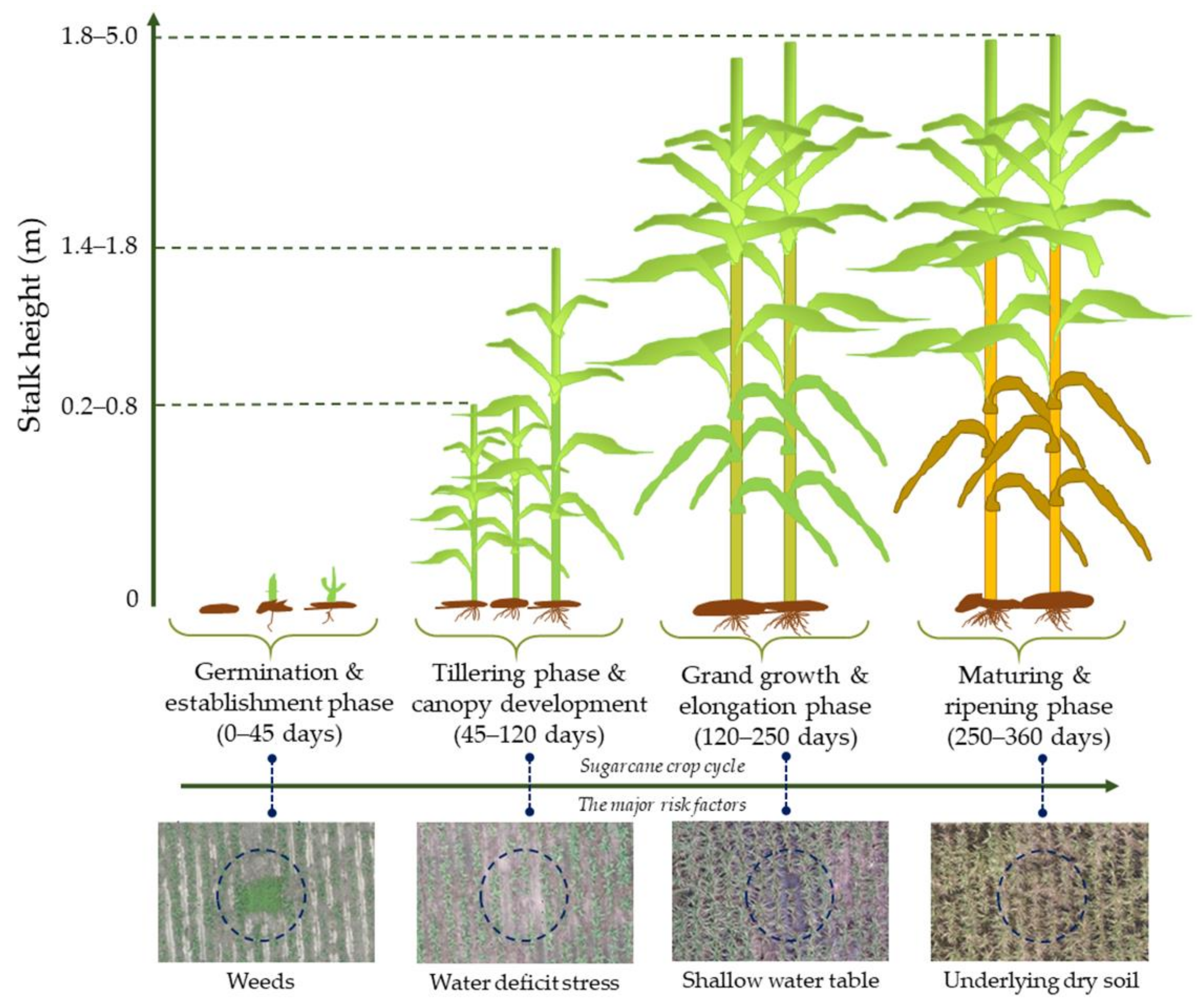



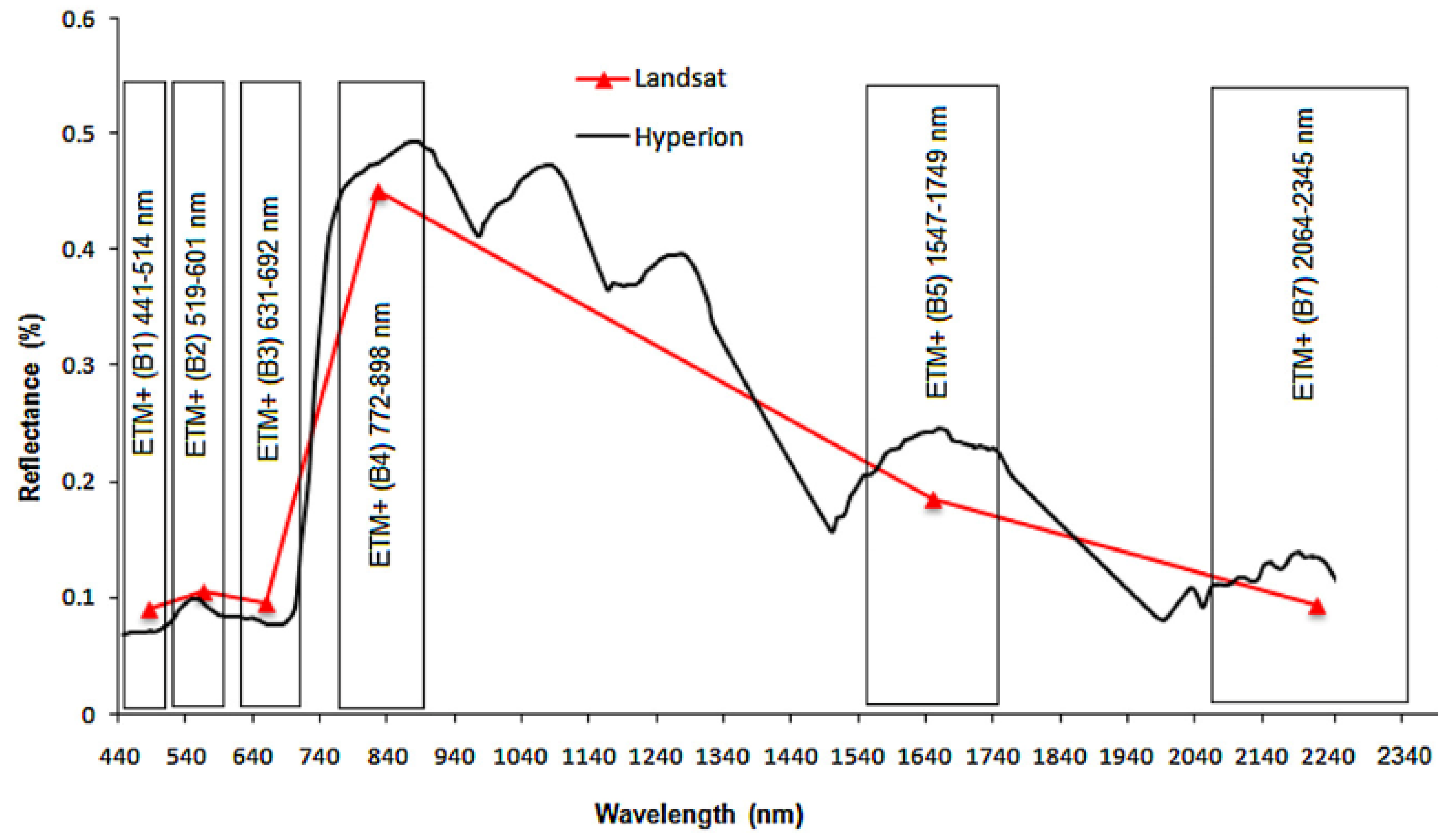

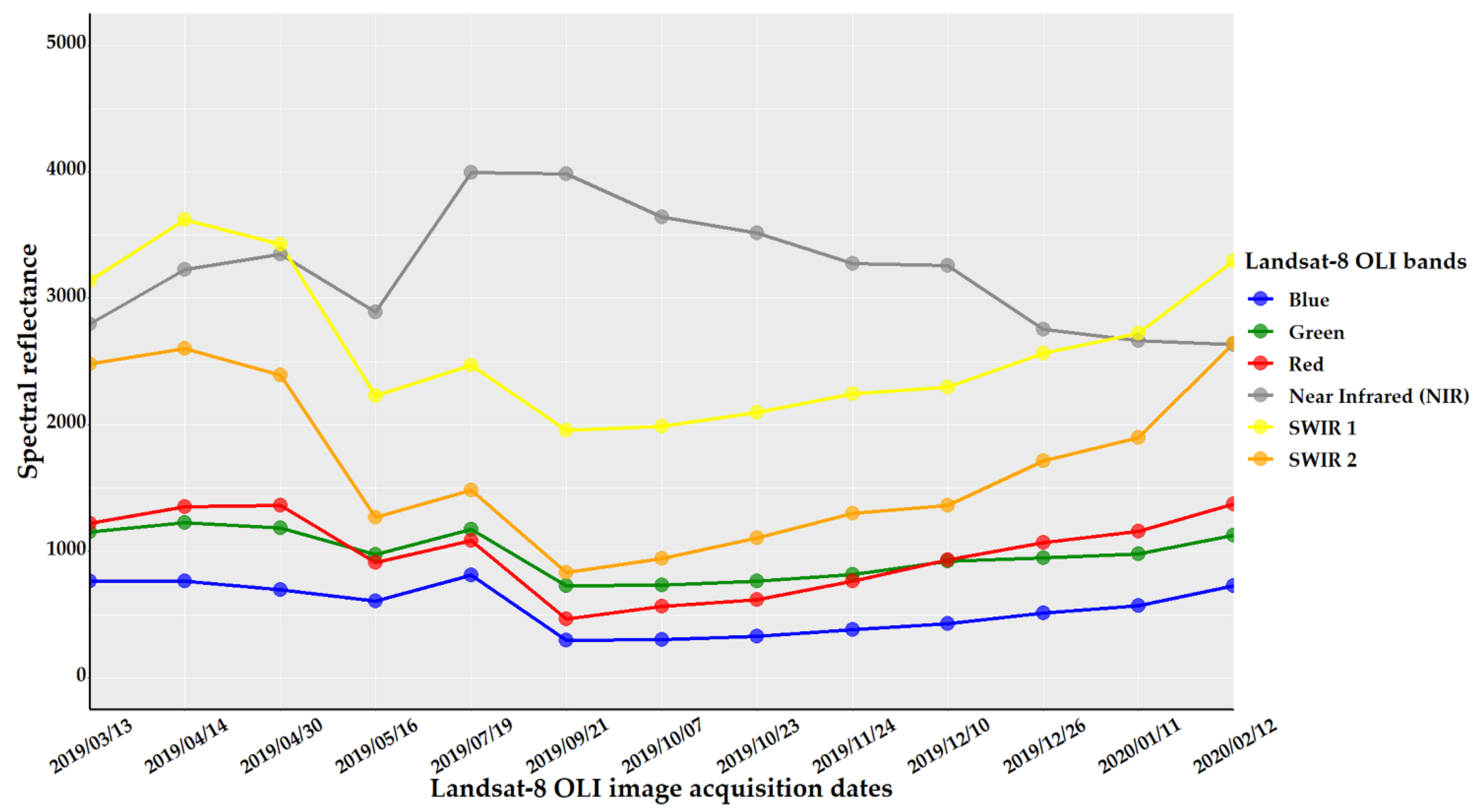

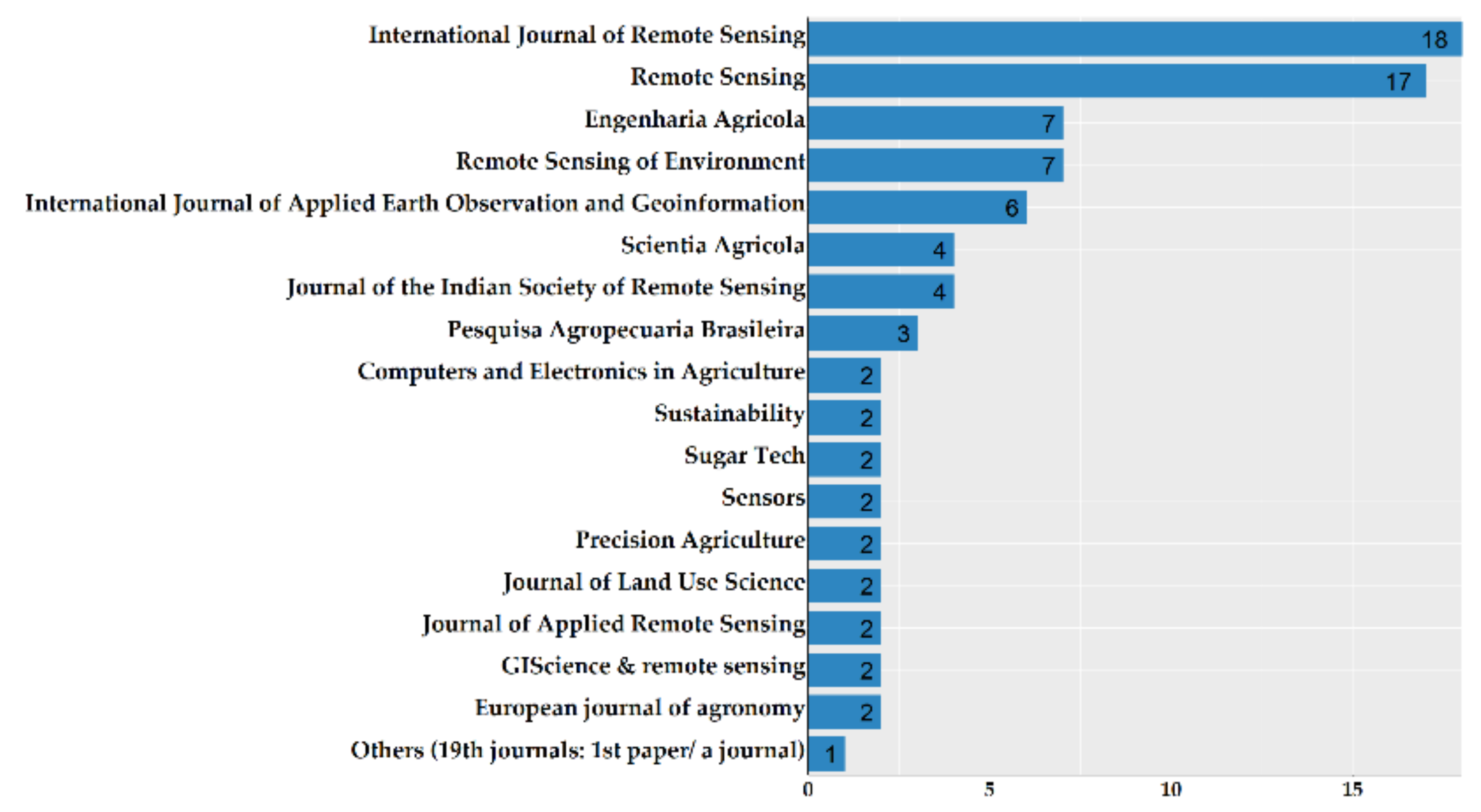
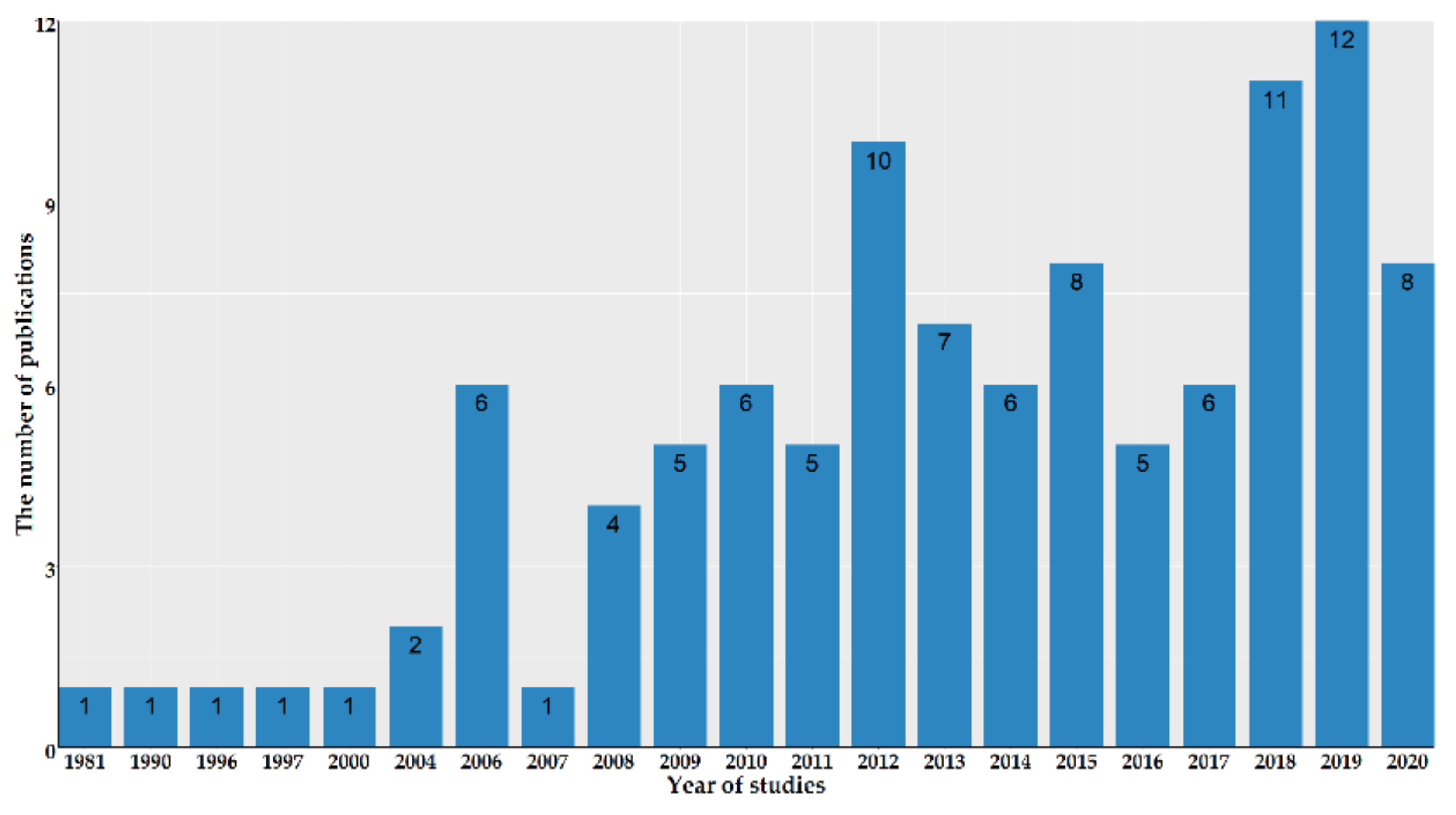
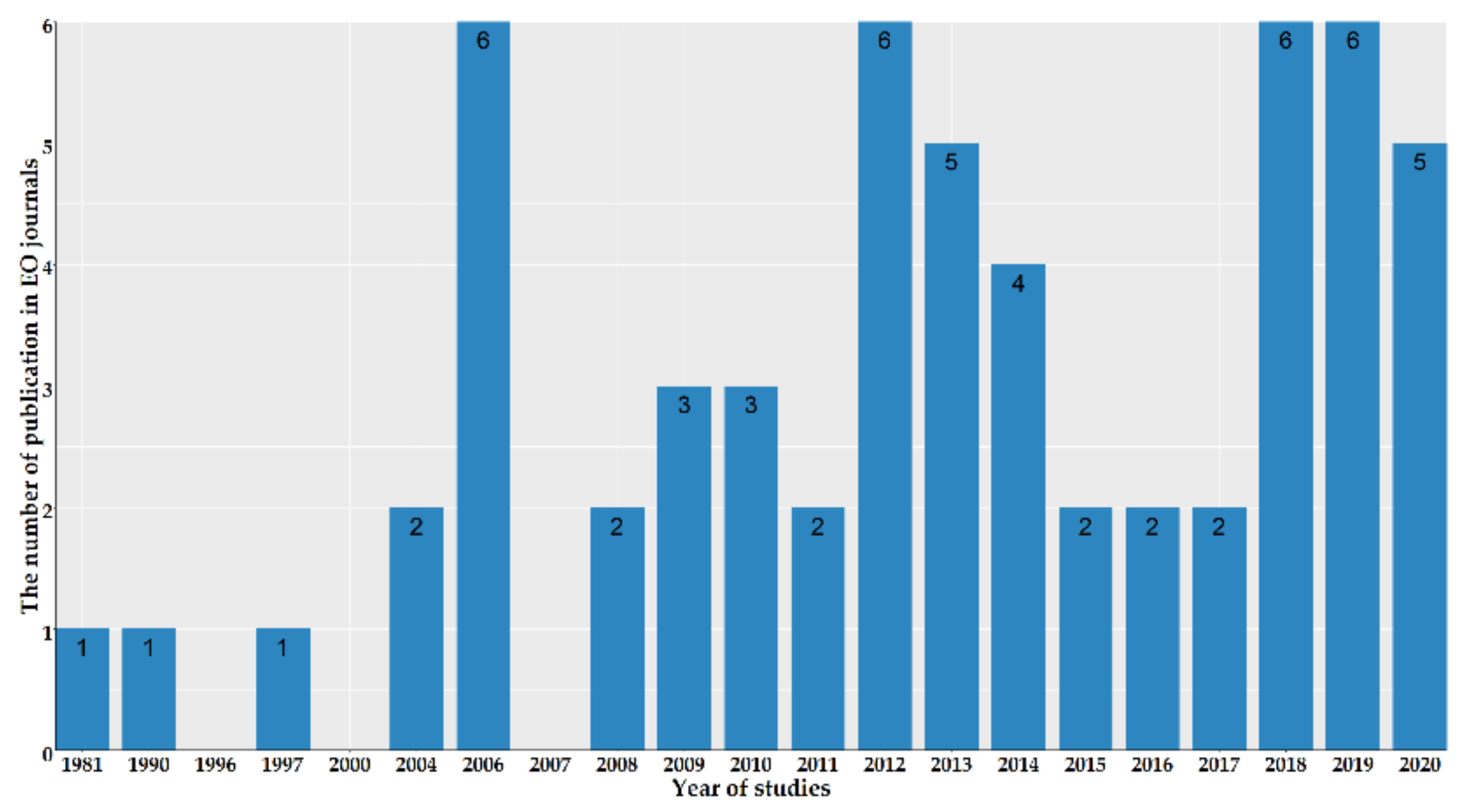
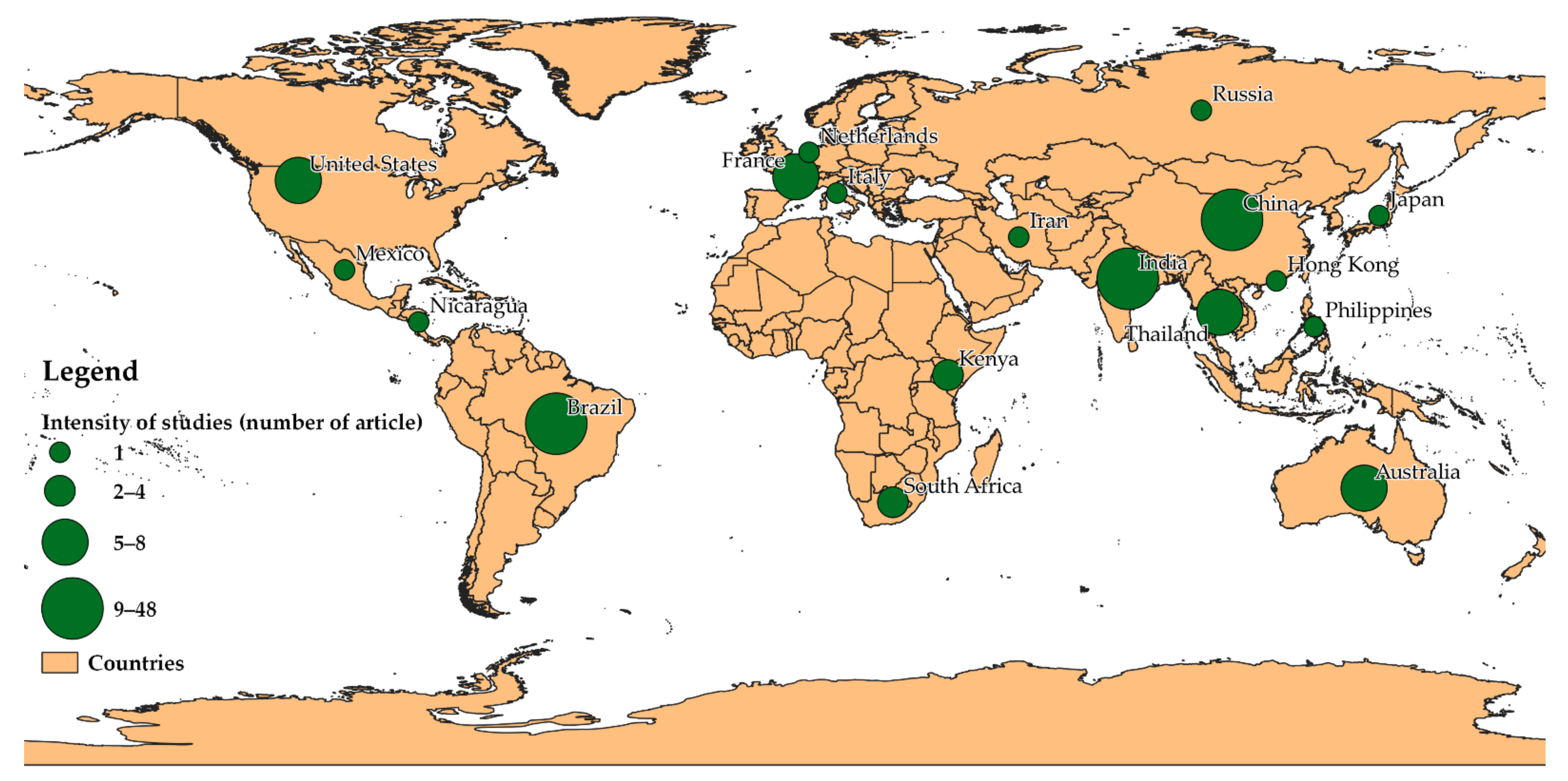
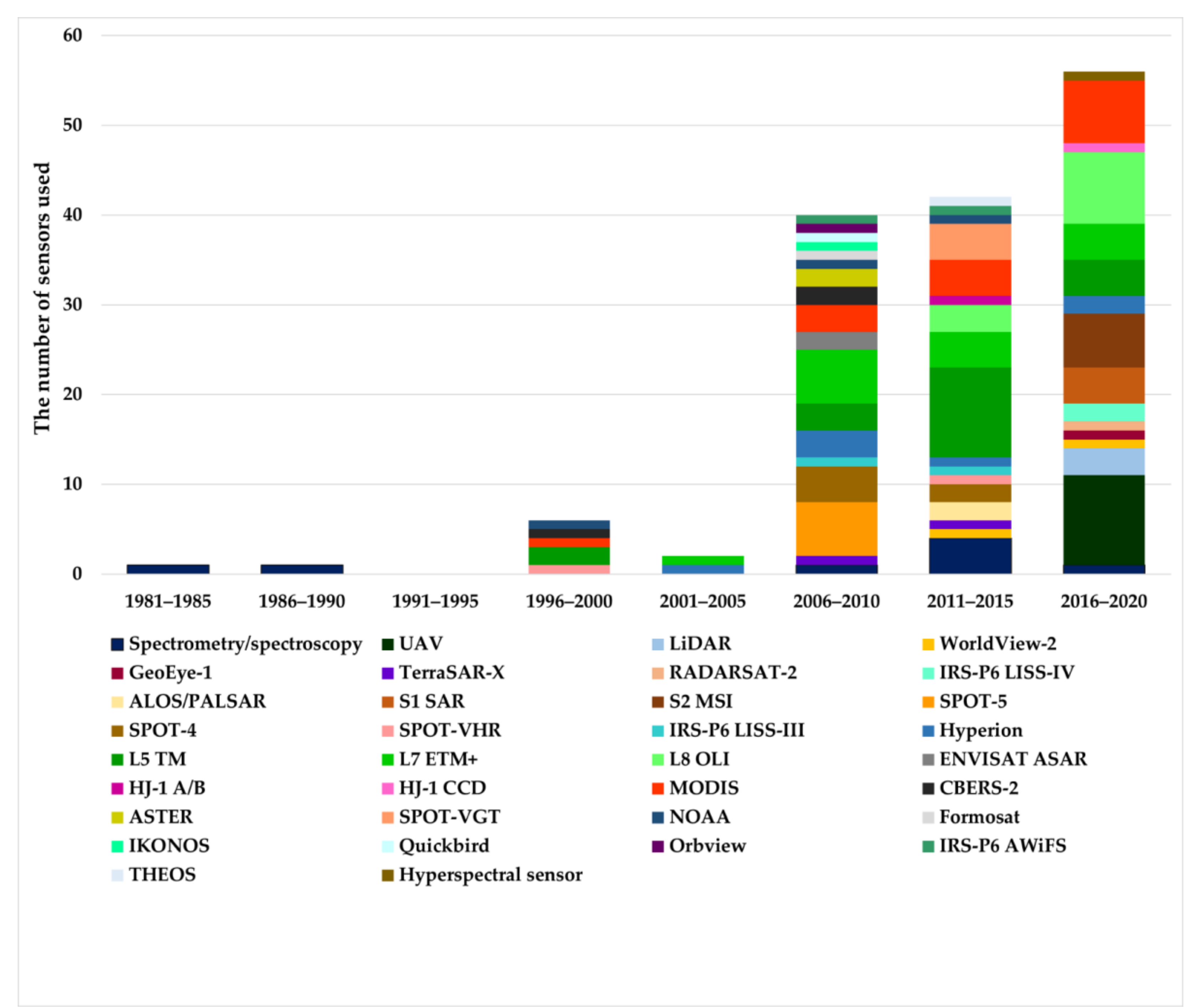
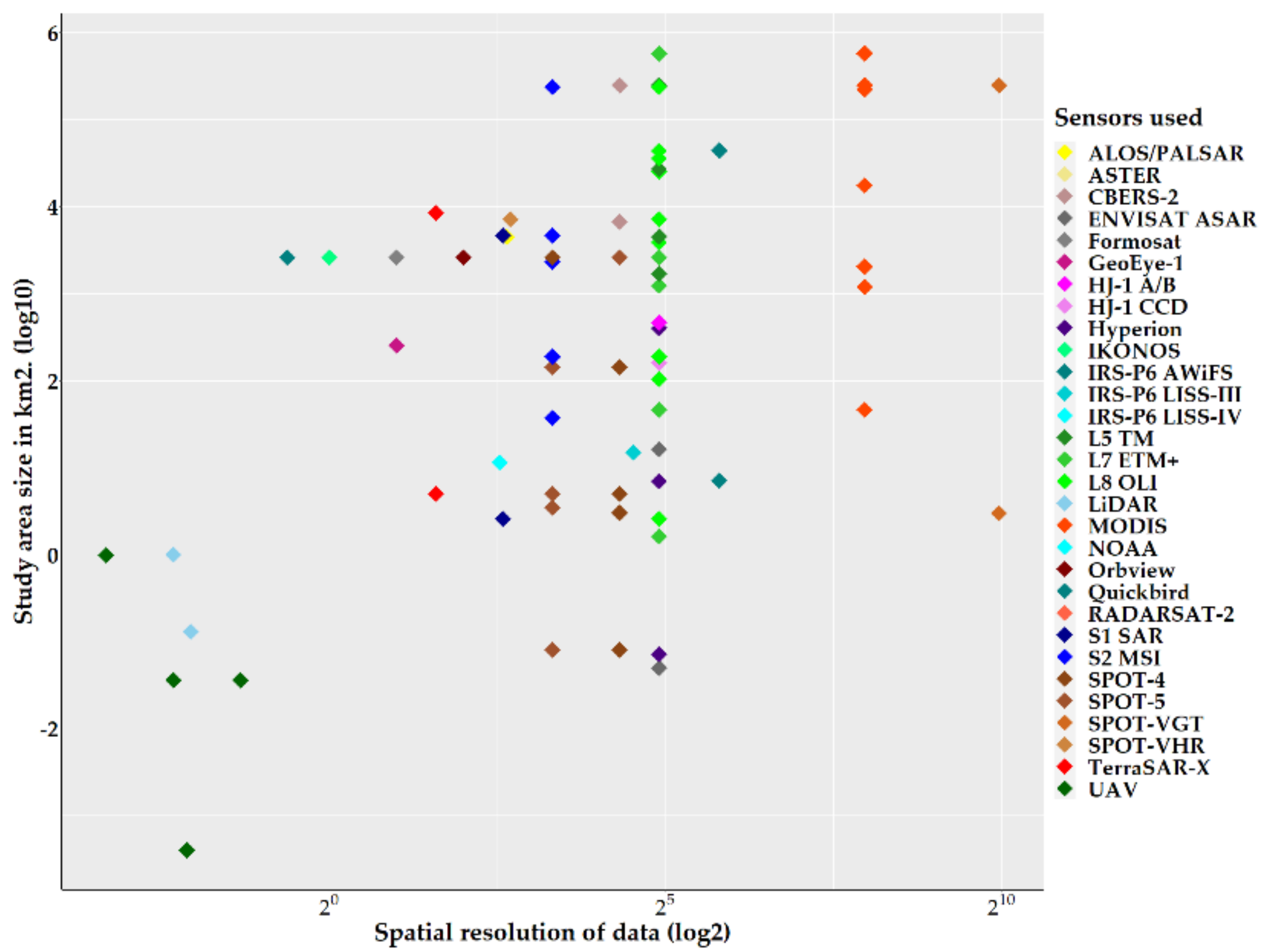





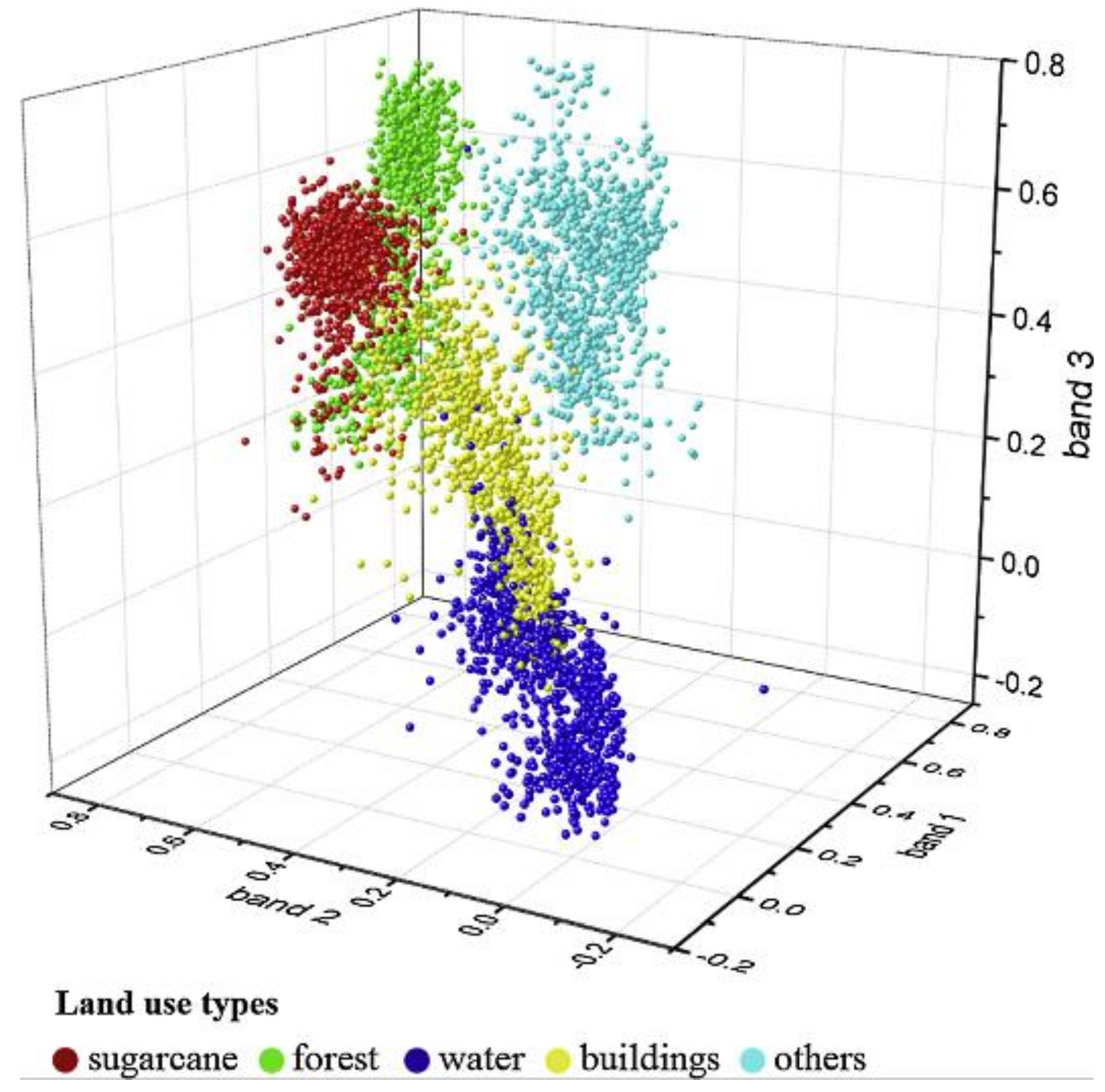
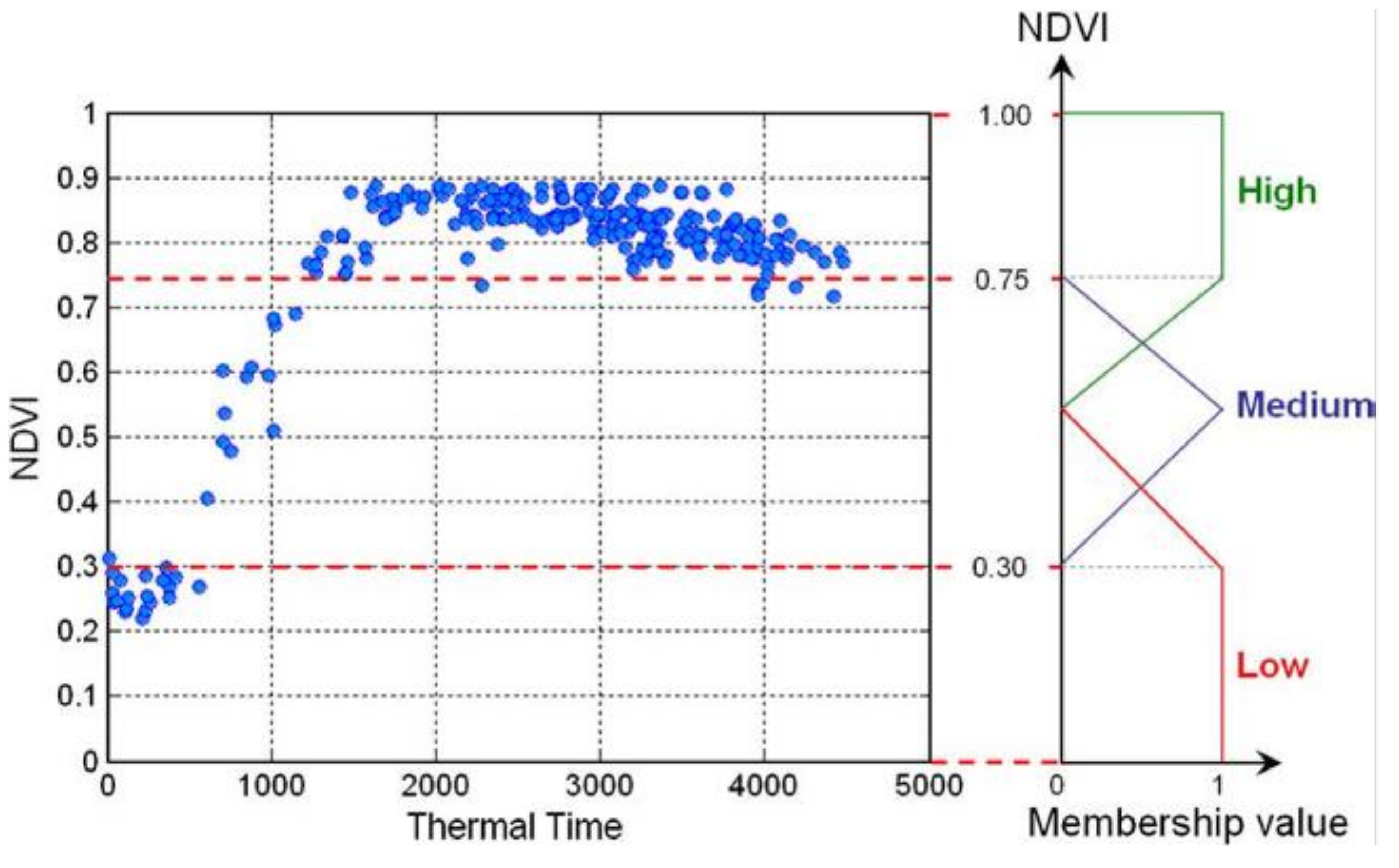


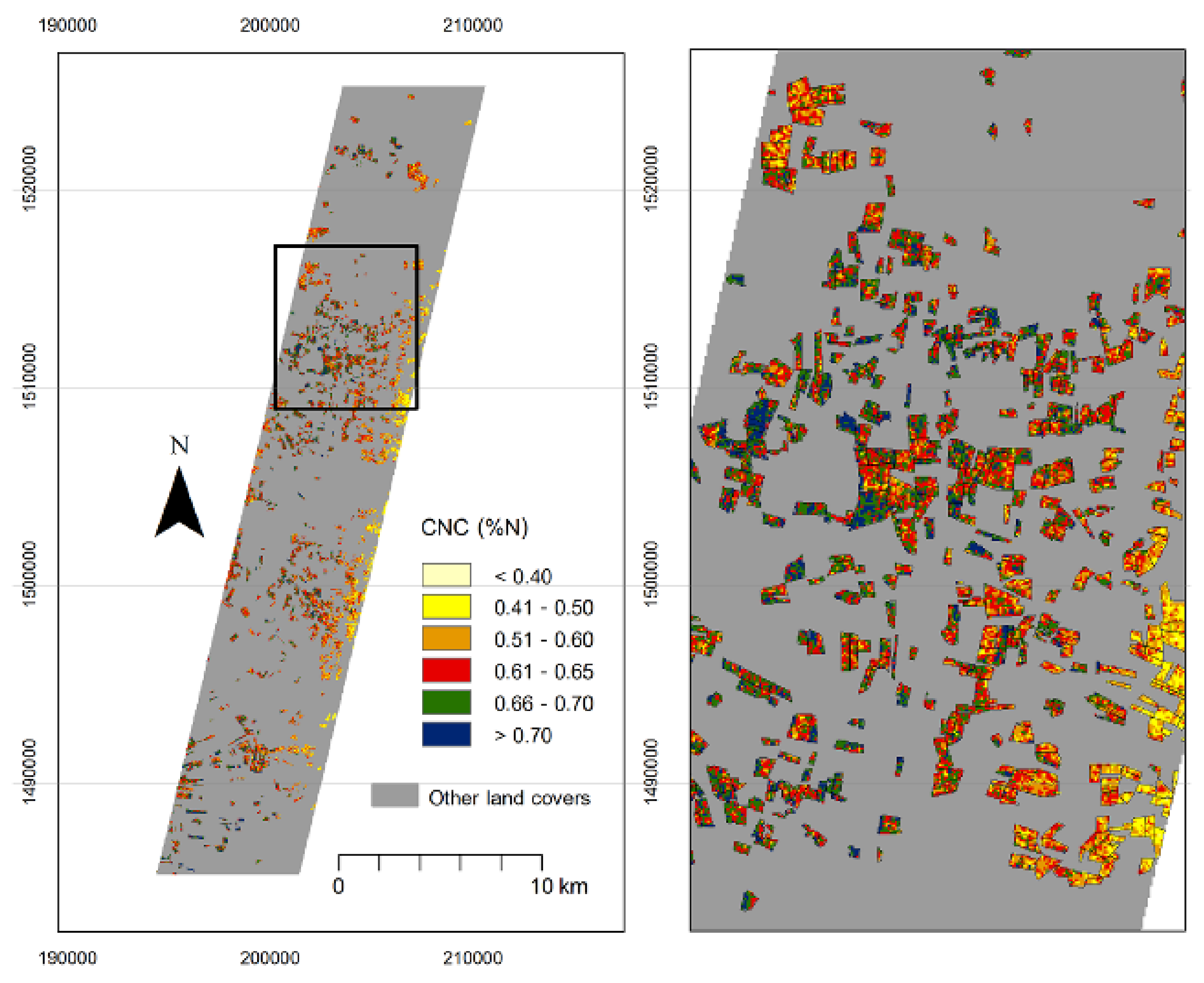
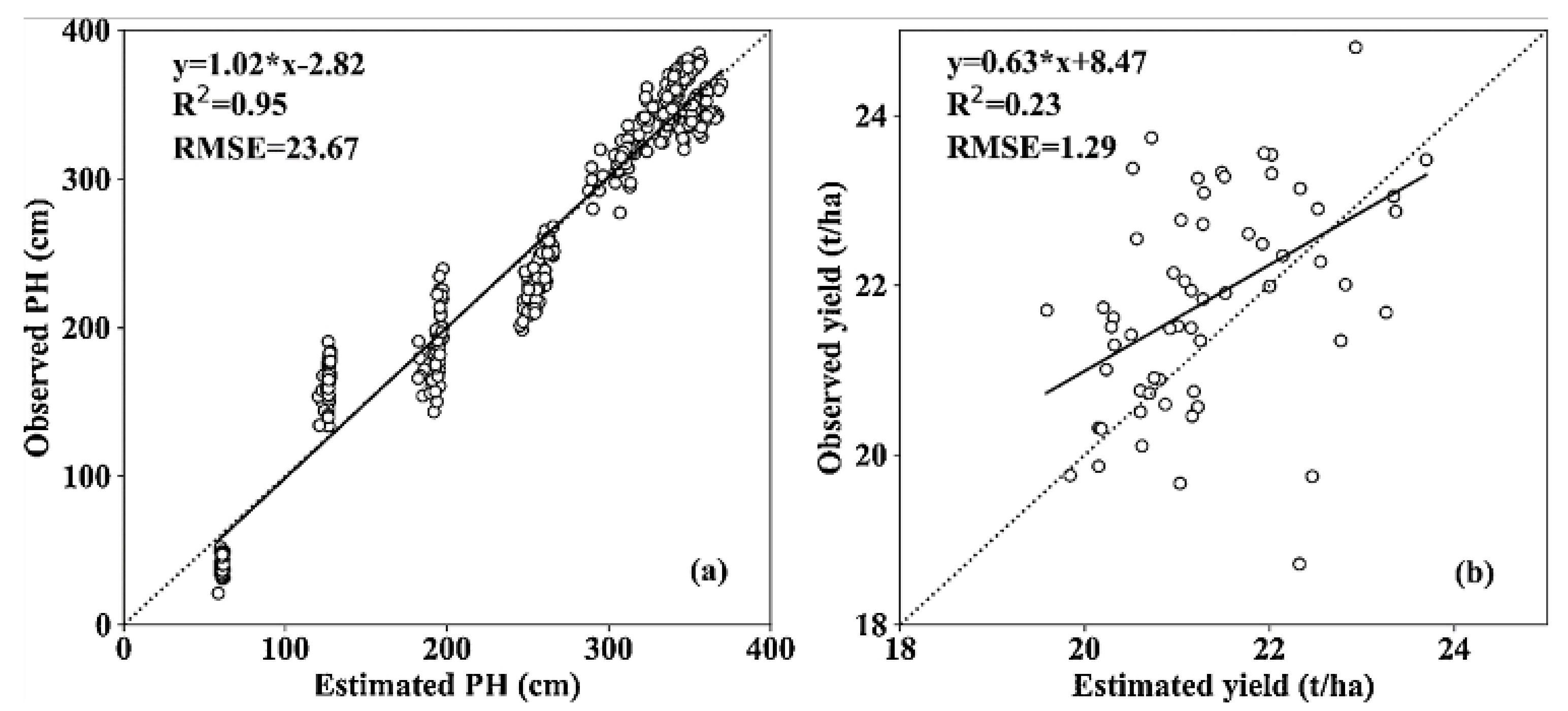

| Country | Sugarcane Planting Information | References | |||||
|---|---|---|---|---|---|---|---|
| Inter-Row Spacing (m) | Row Spacing (m) | Seeding Density (Setts ha−1) | |||||
| Single | Double | Single | Double | Single | Double | ||
| Brazil | 0.20–0.30 | 0.40–0.60 | 1.20–1.40 | 1.50–1.80 | 90,000–150,000 | 170,000–200,000 | [85,86,87,88,89] |
| India | 0.10–0.20 | 0.20–0.40 | 0.90–1.00 | 1.20–1.50 | 37,500–50,000 | 50,000–75,000 | [88,90,91,92,93] |
| China | 0.25–0.40 | 0.45–0.80 | 1.00–1.20 | 1.20–1.50 | 50,000–80,000 | 100,000–150,000 | [81,82] |
| Thailand | 0.10–0.30 | 0.30–0.40 | 1.20–1.30 | 1.40–1.50 | 60,000–75,000 | 80,000–95,000 | [62,94] |
| Spatial Resolution of Sensor (m) | Sensors Used | Number of Studies | Percentage of Studies (%) |
|---|---|---|---|
| <1 * | Spectrometry and imaging spectrometer, UAV and LiDAR | 21 | 14 |
| <10 | WorldView-2, GeoEye-1, TerraSAR-X, RADARSAT-2, Formosat, IKONOS, Quickbird, Orbview, IRS-P6 LISS-IV, ALOS/PALSAR, and SPOT-VHR | 17 | 11 |
| 10 to 30 | S1 SAR, S2 MSI, SPOT-5, SPOT-4, CBERS-2, THEOS, IRS-P6 LISS-III, Hyperion, L5 TM, L7 ETM+, L8 OLI, ASTER, ENVISAT ASAR, HJ-1 A/B, and HJ-1 CCD | 86 | 58 |
| 31 to 250 | IRS-P6 AWiFS and MODIS | 17 | 12 |
| 251 to 1000 | SPOT-VGT and NOAA | 7 | 5 |
| Time Intervals (Years) | Sensor Names and Intensive | Percentage |
|---|---|---|
| 1981–1985 | Spectrometry/spectroscopy (1) | 1 |
| 1986–1990 | Spectrometry/spectroscopy (1) | 1 |
| 1991–1995 | - | 0 |
| 1996–2000 | SPOT-VHR (1), L5 TM (2), MODIS (1), CBERS-2 (1), and NOAA (1) | 4 |
| 2001–2005 | Hyperion (1) and L7 ETM+ (1) | 1 |
| 2006–2010 | Spectrometer/spectroscopy (1), TerraSAR-X (1), SPOT-4 (4), SPOT-5 (6), IRS-P6 LISS-III (1), Hyperion (3), L5 TM (3), L7 ETM+ (6), ENVISAT ASAR (2), MODIS (3), CBERS-2 (2), ASTER (2), NOAA (1), Formosat (1), IKONOS (1), Quickbird (1), Orbview (1), and IRS-P6 AWiFS (1) | 27 |
| 2011–2015 | Spectrometry/spectroscopy (4), WorldView-2 (1), TerraSAR-X (1), ALOS/PALSAR (2), SPOT-4 (2), SPOT-VHR (1), IRS-P6 LISS-III (1), Hyperion (1), L5 TM (10), L7 ETM+ (4), L8 OLI (3), HJ-1 A/B (1), MODIS (4), SPOT-VGT (4), NOAA (1), IRS-P6 AWiFS (1), and THEOS (1) | 28 |
| 2016–2020 | Spectrometry/spectroscopy (8), UAV (10), LiDAR (2), WorldView-2 (1), GeoEye-1 (1), RADARSAT-2 (1), IRS-P6 LISS-IV (2), S1 SAR (4), S2 MSI (6), Hyperion (2), L5 TM (4), L7 ETM+ (4), L8 OLI (7), HJ-1 CCD (1), MODIS (7), and Hyperspectral sensor (1) | 38 |
| Classifier Approaches | Sensors Use | Pros | Cons | Publication |
|---|---|---|---|---|
| CM | HJ-1 CCD, Hyperion, MODIS, and NOAA |
|
| [130,145,165,166,167,168] |
| RF | S1 SAR, S2 MSI, L5 TM, L7 ETM+, L8 OLI, SPOT-VHR, and Hyperion |
|
| [34,43,49,117,169] |
| OBIA | UAV, LiDAR, HJ-1 A/B, L5 TM, L7 ETM+, and RADARSAT-2 |
|
| [3,58,73,74,106,170] |
| LDA | UAV, Hyperion, and L7 ETM+ |
|
| [7,117,141] |
| MLC | THEOS, L5 TM, L8 OLI, LISS-IV, and IRS (AWiFS) |
|
| [162,163,171,172,173] |
| PCM | WorldView-2, LISS-III, and ALOS/PALSAR |
|
| [174,175,176] |
| SVM | S2 MSI, Hyperion, L7 ETM+, and L8 OLI |
|
| [35,45,117,177] |
| DT | S1 SAR, S2 MSI, L5 TM, L7 ETM+, L8 OLI, and LISS-IV |
|
| [155,172,178] |
| Vis.Int. | MODIS, L5 TM, and L7 ETM+ |
|
| [56,179,180] |
| ANN | S2 MSI |
|
| [35] |
| CNN | S2 MSI |
|
| [181] |
| ISODATA | LISS-IV |
|
| [172] |
| PDA | Hyperion |
|
| [117] |
| XGBoost | S1 SAR and S2 MSI |
|
| [43] |
| MDC | Hyperion |
|
| [45] |
| SAM | Hyperion |
|
| [45] |
| Number of Studies | Methods | Sensors Use | Pros and Cons | Publication |
|---|---|---|---|---|
| 4 |
| Image time series
|
| [72,219,220,221] |
| 3 |
|
|
| [222,223,224] |
| 3 |
|
|
| [42,89,225] |
| 1 |
|
|
| [226] |
| Number of Studies | Methods | Sensors Use | Mean RMSE Accuracy (t/ha) | Pros and Cons | Publication |
|---|---|---|---|---|---|
| 12 |
| Spectrometry Image time series
| 7.36 |
| [115,124,132,146,148,159,160,161,238,239,240,241] |
| 7 |
| Spectrometry Multi-temporal images
| 12.98 |
| [44,97,149,186,230,242,243] |
| 6 |
|
| 1.29 |
| [3,46,47,84,244,245] |
| 4 |
| A single image data
| NA |
| [105,246,247,248] |
| 1 |
| Image time series
| 8.2 |
| [249] |
Publisher’s Note: MDPI stays neutral with regard to jurisdictional claims in published maps and institutional affiliations. |
© 2021 by the authors. Licensee MDPI, Basel, Switzerland. This article is an open access article distributed under the terms and conditions of the Creative Commons Attribution (CC BY) license (https://creativecommons.org/licenses/by/4.0/).
Share and Cite
Som-ard, J.; Atzberger, C.; Izquierdo-Verdiguier, E.; Vuolo, F.; Immitzer, M. Remote Sensing Applications in Sugarcane Cultivation: A Review. Remote Sens. 2021, 13, 4040. https://doi.org/10.3390/rs13204040
Som-ard J, Atzberger C, Izquierdo-Verdiguier E, Vuolo F, Immitzer M. Remote Sensing Applications in Sugarcane Cultivation: A Review. Remote Sensing. 2021; 13(20):4040. https://doi.org/10.3390/rs13204040
Chicago/Turabian StyleSom-ard, Jaturong, Clement Atzberger, Emma Izquierdo-Verdiguier, Francesco Vuolo, and Markus Immitzer. 2021. "Remote Sensing Applications in Sugarcane Cultivation: A Review" Remote Sensing 13, no. 20: 4040. https://doi.org/10.3390/rs13204040
APA StyleSom-ard, J., Atzberger, C., Izquierdo-Verdiguier, E., Vuolo, F., & Immitzer, M. (2021). Remote Sensing Applications in Sugarcane Cultivation: A Review. Remote Sensing, 13(20), 4040. https://doi.org/10.3390/rs13204040








